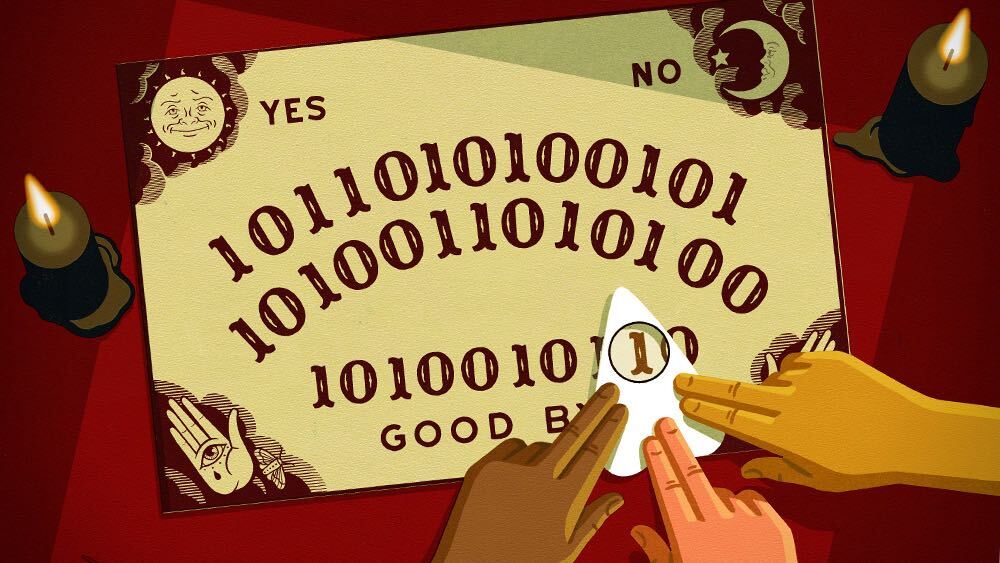
Pete Ryan
Opening salvo: Divining the future of B2B is not unlike a seance. We enter a candlelit room with childlike wonder straining our senses to hear voices from the past out of the “great beyond.” We unite our hands to commune with ghosts, but there’s always that sneaky friend that surreptitiously spells words out of the corner of their eye.
We are all standing on the shoulders of giants, specters of the past, present, and future as Todd Caponi would help us believe. Are these really trends, or predictions, or “just a little history repeating?” Most of the same prognostications were made in sales journals from 1916 when Woodrow Wilson headlined the equivalent of ‘Dreamforce.’ Back then, sales was vaunted as the future of economic superiority.
As Editor/Founder of GTM Mag, I’ve decided to make this month’s “Big Question” a tableau vivant of fact, opinion, art, and science. A broad-spectrum analysis by Forrester-caliber friends is featured. Futuristic meanderings capture impressionist hope and optimism after a dark chapter of dehumanized selling and marketing remotely.
I highlight recurring themes like the Great Resignation, Demand Gen vs. SDR debate, the coming convergence of sales and marketing as one function, RevOps, PLG, and even CLG – Customer-Led Growth. Our ability to thrive and scale entrepreneurial ideas will vastly accelerate by engraining Diversity, Equity, Inclusion & Belonging into the culture as DNA.
GTM Mag is an independent entity mission-driven to elevate your GTM. It’s not affiliated with any other GTM brands and will not contain ads. I’m beyond grateful to share so many diverse voices and opinions – some who feel like it’s all going forward, some backward, and some frustratingly stagnant as the tech itself seems to have amplified toxic behavior.
I traveled to Venice in 2019 to attend La Biennale di Venezia, the boldest, multi-country art exhibition in the world. Looking back, I get chills to think of the theme because I can’t believe everything that happened right after! It echoed Robert Kennedy’s quote from a speech in Cape Town in June 1966. A Chinese curse, ‘May you live in interesting times.” Like it or not, GTM is about to get very ‘interesting’ even mesmerizing.
If you’re sufficiently transfixed, want to contribute, opine, or submit ideas, grab your nearest Ouija board and drop me a line at [email protected].
Thank you to the award-winning illustrator Pete Ryan for visual inspiration. (New Yorker, Time, Barron’s, WSJ, NYT, Washington Post, Economist, Buzzfeed, TED)
2022 will be the “year of the sales manager.”
As we move into 2022, we face new and age-old challenges. Consumers are changing their purchasing habits to overcome sluggish supply chains; retailers are struggling to serve customers due to labor shortages; social media platforms are amplifying political and cultural divides, and in the United States between June and August 2021, 12.1 million workers voluntarily quit their jobs.* Fueled by “The Great Resignation,” the smoldering war for talent is in a full-on burn.
In the world of B2B buying and selling, these challenges are juxtaposed with technological innovation, sweeping demographic shifts, and rapid sales technology consolidation. My recent research conducted in conjunction with Forrester Consulting (to be published in early December) revealed that sales leaders representing over twenty industries and based in North America and the UK understand the world of buying and selling has dramatically changed. It is against this backdrop and based on these survey findings that lead me to predict that in 2022 sales leaders will:
1. Adapt to the changing landscape. In the early days of the pandemic, some sales leaders, particularly those from more traditional businesses, chose to wait for the return to normalcy on the sidelines. Now more than two years later, sales leaders will adopt a digital-first mindset. In addition to relying on technology and data, this 2022 cohort will also lean into the operational aspects of their role. In our study, sales leaders identified having financial acumen and delivering predictable, efficient growth as the top two attributes for their role.
2. Invest heavily in upskilling and reskilling.
In the hyper-hybrid world of buying and selling, sellers need new skills to layer on top of traditional methods.
In response to sweeping demographic changes, larger distributed buying groups, and much more, sales leaders plan to invest heavily both in internal enablement programs and external specialty training for their individual contributors and managers. My “call” is that 2022 will be the “year of the sales manager.” While this role has been historically under-supported, in 2022, sales managers will finally get the training and support they crave and deserve.
3. Embrace the science of forecasting. To date, forecasting at many organizations has been inefficient and ineffective. In our sales leader survey, 60% of respondents said they don’t have a well-defined or scientific approach to forecasting** and in a recent LinkedIn poll, 25% of respondents said their organization spends over 100 hours a week in forecasting activities.*** In a world where volatility is the norm rather than the exception, sales leaders will turn to revenue operations and intelligence solutions to enable them to have the real-time visibility to course correct and commit with confidence.
4. Lean into diversity, equity, and inclusion. While sales leaders stateside and across the pond, talk the talk regarding DE&I not everyone is walking the walk. UK-based sales leaders are further ahead of their US-based counterparts in prioritizing the activities that will enable them to build a diverse sales organization. As the war for talent blazes on, sales leaders everywhere will need to get more creative with their talent acquisition and retention strategies and focus on building teams that reflect the world around them. My research shows that sellers want to work for, and buyers want to partner with organizations that align with their values.
*“Young People Are Leaving Their Jobs In Record Numbers – And Not Going Back”, TIME, October 29, 2021
**60% – BASE: 212 sales leaders in various industries across North America and the UK, Outreach.io
***Source: a commissioned study conducted by Forrester Consulting on behalf of Outreach Corporation LinkedIn poll conducted by Outreach with 65 respondents, September 2021
Long-form content is the most successful emerging channel.
Are you building a solid GTM for 2022?
1. I think long-form content, especially podcasts, is the most successful emerging channel we’ve had in a while.
2. Conversation Intelligence functionality (like the Gongs of the world) are helping sales and marketing organizations from the inside out, especially the ones who understand them. It’s beneficial for enterprise sales and marketing organizations that have a lot of people. I think the insights they get from that are proving to be very valuable.
Those are two of the biggest things in the last few years.
Overall, the objective of any organization is to demonstrate their expertise in various areas: to find people they know, like, and trust that can lead them in identifying blind spots. They endeavor to think of things differently and make sense of the world right now. Nobody knows what’s going on or what’s coming. When faced with uncertainty and doubt, people fall back on the things they know best, always looking for people who can give them new ideas.
Before, I always thought those things were the right things to approach sales and marketing; from a buyer’s perspective, to seek value-add from vendor communities.
JN: What’s your take on PLG?
It’s another nice fashionable term that will have its lifespan like any other. I have never been a fan because you learn faster and get more of what you want when you’re as high touch as you possibly can be.
PLG is a way for people who are afraid to talk to humans to justify their behavior on learning.
We live in a world where people talk about their successes, not their failures. There are just as many failures in any given approach. Your job is to help other people be successful in what they want to be doing. If you can’t tie yourself to that, you’re not going to build a lasting, sustainable business. Anything that removes you directly from the human puts you at a greater risk of not being successful than what you do to create more humanity in Sales and Marketing. We’ve lost a lot in the last 20 years. There’s an over-reliance on technology and screens by everyone. The most human sellers and marketers are the ones who will be most successful now.
JN: Will sales and marketing ever get along?
Sales and marketing, unfortunately, have been at odds. Sales blame marketing because the leads are weak, and marketing responds, “you can’t close the stuff I give you.” There’s a defensive attitude and unhealthy friction between both sides that is silly. Individual sellers and marketing working together is the first stage of creating something new. Then you get new behavior.
Individuals by themselves are beautiful, engaging, and dynamic, and if you get a couple of learners, you see a lot of success in the learning phase. You can find the truth about where a new product fits in the market and what to do about it. But the minute you start to expand into groups, group behavior takes over. Group behavior tends to be ‘fixed’ in its approach, and it tends to be much more of a herd mentality. It becomes much less exciting and much more “lizard brainy,” if you will, in terms of how people behave. Factions and tribes grow. Marketing and sales orgs don’t get along as they should. Blame the leaders on both sides, whether the CEO, CRO, or COO, for not creating more alignment between sales and marketing. Philosophically, if you don’t share the same values, it causes all sorts of problems.
People fall back on what they know and what they think they want to be in sales. It’s not what society teaches us. They teach us and reinforce, “sales is snake oil,” retail mattresses, and used cars. We learn that it’s highly transactional and invented to be highly transactional. “Nothing happens until someone sells something.” To this day, I experience that every day.
Sales solves the most problems. Digital marketers sit behind a screen and create things, click on buttons, and adjust Hotjar maps. Some are better at data, some better at creating – I’m not surprised you’re running into that – standard thinking. We rely too much on the tools or what society has been conditioning them on forever, frankly.
Now we live in a world where it’s never been more valuable to understand what differentiates us is not what we sell; it’s what insights we bring—being focused on business outcomes instead of the top-down, inside-out Go-To-Market strategy, as opposed to the outside-in. Being focused on the user and the buyer, who they are, who their customers are, and their customers’ customers. That entire value chain and how they contribute to it, where products can create the value, and where opportunities matter.
The pace of change is generally faster than it’s ever been. Standing out in front of this stuff is no longer about products and technology as much as it is about how you think and how you behave. How will you react to these changes that are coming, whether you like it or not?
In my corporate innovation business U+ we’re all about advocating for a ‘fast follower’ strategy. Understand what technologies and tools people are adopting and how you can build and deploy the same things to meet your user’s needs to stay relevant and out in front. Most people don’t think that way. They believe inside out from themselves out to the world as opposed to the world back into itself.
Get comfortable with augmented intelligence.
I demure when I’m asked to make predictions because I don’t think I can see any further past the tip of my nose than the next person. Since I had the luxury of reading others’ predictions, I’ll mostly muse instead.
On PLG and Human Selling: Pundits have a few well-worn tricks up their sleeves. One is to take a painfully obvious current trend (PLG) and rename it (freemium anyone?) pretend to have invented it or amplify its near-term impact. Bill Gates said it best, “Most people overestimate what they can do in one year and underestimate what they can do in ten years.” Another is to promote the contrarian point-of-view (human-centric selling) as the burgeoning new-normal. Each ‘side’ is embracing a false dichotomy. The timeless trend is that the dollar threshold between self-service and human-service simply moves up over time in nearly every market segment. For example, ATMs have long since replaced most of what bank tellers used to do yet trusted financial advisors for the wealthy are still in high demand. Sure, there has been some PLG trend acceleration as buyers have become more digitally savvy and tools have made freemium viable for narrower market segments. However, I don’t see anything unusual here.
On Sales Tech Stack Consolidation: No duh.
On the Death of Outbound: Another pundit favorite is to say “x is dead.” Here I turn to Mark Twain for wisdom, “The reports of my death are greatly exaggerated.” (Side note: This was not his exact phrasing but the spirit of the quote is accurate). Sure, many best practices die over time (telegraph); I’m not so naive as to believe everything lasts forever. However, I’d want to see more actual data before I call this one.
I can safely say that if you took two head-to-head competitors and one of them turned off their outbound channel then I’d know which one would survive.
I could go on but you get the point.
Now, it sounds like I’m just bashing others’ ideas but I’m not. I’m using my soapbox to encourage you to think critically about what you read and hear from me or anyone else.
What do I believe? Having studied engineering, economics, and statistics, I believe in data, trends, historical repetition, and mean-reversion. Will PLG become more pervasive? Yes. Will human-selling also be important, especially at higher price points? Yes. WIll the Great Resignation put upward pressure on wages? Yes – at least until the next recession – triggered heavily by the aforementioned wage inflation. Will sales tech companies gobble each other up? Yes (and ditto for CS Tech, MarTech, and ‘fill-in-the-blank’ tech). Consolidation waves are timeless. Will DEI grow? Yes, but sadly more slowly than good humans would hope. Is outbound dead? No, but we need to continue to be vigilant about accurate targeting and value-forward engagement. Have we overspecialized sales roles? Yes in many contexts but not in all. Is variable compensation dead? No. Will AI/ML continue to have a greater-and-greater impact on sales productivity? Absolutely.
As a final exercise in critical thinking, here is what excites me about the application of AI/ML in sales in 2022. (Again, I don’t claim any of this is new).
- Prospecting: Auto-sourcing look-alike accounts & contacts. Optimizing messaging based on what is known to be working at the moment based on 100s of millions of interactions (see Email Optimizer – yeah it’s free).
- Opportunity Management: Accurate forecasting not only of active opportunities but also of business that will be sourced and closed in the period of interest.
- Customer Success: Actually delivering on the largely unmet promise of being proactive rather than reactive to prevent accounts from going ‘red’ to begin with.
If there is a thread that runs through all of these for me, it is the progression of platforms from descriptive (what) to diagnostic (why) to prescriptive (what next). In simpler terms, machines will get better at recommending next best actions to sellers. We are not (yet) at the point where machines can fully replace humans, especially not in complex, solution-oriented sales. At the risk of stating the obvious, now is the time for sales professionals to get comfortable with augmented intelligence.
Conversations are becoming a lost art.
I’m tracking three main trends that have to do with work, safety nets, and status.
We must use these to our benefit and take away the things that avoid the issues. I realize this is not the layer of a hard technical subject.
I have a friend who is a senior executive at Intuit, running ads, and honestly, he’s getting bad candidates. The only way forward is proselytizing, going to LinkedIn, looking at candidates’ backgrounds. “We’re at Intuit, looking at them, telling them to check this out.”
Nobody day trades now. The computers take all the Alpha; you cannot fish. The metaphor is like deep-sea fishing at scale. Chinese fishing vessels take all the fish. How can you compete with 2,000 miles of nets when you have a single line?
You can’t fish, you can’t day trade, and you can’t recruit using the recruiting platforms. The massive algos from big companies already know how to get the best candidates. You have no chance as an individual recruiter!
Let’s look at lead generation. Because of the volume and automation, you can get leads. It used to be easy to get somebody to talk with you. Today, people are coming to you: pay me $20, $200, or $2,000, and I’ll get you leads. In the past, that was a dead end.
You can do these programs on LinkedIn that are relatively simple to get leads. So another hidden analog trend is the “lost art of sales.” It was the only thing people had 20 years ago. My Vortex event attendees are often in their 40s and 50s.
We’ve lost the ability to sword fight. We can run ads, run AB tests that nobody understands, sell the tripwires, and sell the recurring revenue. But when it comes to account-based sales, at some point, when every single one of these SaaS businesses (or courses) gets big enough, they have to start talking to people. When they need to close accounts at 25K-50K, those conversations are becoming a lost art.
The pandemic has kicked off additional themes. A friend of mine runs an 8B P&L at GM… When you do a Zoom call with him, he’s at his house in Malibu. Zoom removed the hard-to-fake signals. It’s a “hard-to-fake signal,” my $500K LED wall (behind me) in an existing facility. Imagine I pop up on an account-driven call. In the old world, the dealmaker would be in an office and have the infrastructure behind them.
There’s confusion about where anybody is in the hierarchy now. What power, control, or ‘juice’ do executives have? I just see your face and a wall. It’s hard to know it’s a CEO of a public company worth 50MM or even 600MM.
I built this facility. I’m the only one that works here except Liz, a supermodel. Why not build these in for the CEOs? What power do you have to make things happen now? I can only see your face and wall. There aren’t status cues. How do I get above and around you when I can’t identify your place in the social hierarchy?
Etch a sketch and loss – turned upside down. As a C-Level running Mobility for one of the top 2 car manufacturers, if he comes on the call and doesn’t mean anything to you, there aren’t status symbols to identify his authority.
Our concept of “status” has been thrown entirely up for grabs. We have reached a scary point where you have non-experts told by Russell Brunson that they are now an expert. People become experts in Marketing via massive campaigns. Thai Lopez teaches a real estate course but doesn’t know what a cap rate is.
There’s a vast gap between the premise/promise of these courses vis-a-vis the material you used to get. When you got a Ph.D. in Physics from Harvard or Stanford, Florida State, University of Delaware, that meant something. Even Masterclass – Venus Williams is not going to teach you tennis! She’s a gifted athlete but not necessarily an educator. As a college professor, my dad taught me it’s the business of education to know the topic deeply.
It’s not just education. 99% of talking head energy gets invested in “The Funnel.” We’re at peak “everybody has a course” on some random thing that they know at a peripheral level. Even if they do know it deeply, does the course deliver education? The people that know how to do stuff don’t want to run for Politics.
The youth’s outlook toward work is reaching a level of “madness.” I randomly hired someone recently. When they finished for the day, they just left. Out for breakfast… 35 min, no breakfast had shown up. Lofty Coffee – a high-end place. The excuse was, “We’re short-staffed.” The “whole world” is short-staffed.
The safety net is “I can Uber” or “get on Fiverr” – multiple, multiple safety nets. When a 21-year-old jumps off a building, they think, “someone will catch me.”
Nearly every business plan presented to me, there’s somewhere where a miracle has to happen, but they don’t have that in place.
To predict the future, look backward.
Perennial. You plant the flowers; next year, they come back up – the same arguments are coming up over and over again.
To predict the future, look backward. Have people ever decided not to be around each other? Never. Wrote down in June 2020, everybody is going back in the office. They can’t work alone.
There’s none of the creative tension when people are solving problems. It’s difficult to communicate well.
I wrote this down a long time ago. These young kids coming out of college are quitting their high-paying jobs like working at JPMorgan Chase. At the age of 24-25, you have no idea how to operate in the company, and they’re by themselves at home.
It’s right here in your heart, and you want to be around people. We can’t avoid “humans being humans.” We go back to where we’ve always been.
It’s getting harder for buyers to buy. It’s hard to buy internally and externally. 70% have buyer’s remorse. The research gives them an insight but no fit or structure of the relationship. That matters deeply if you’re going to work with someone.
In staffing, my Mom won the first client. We’ve had them for 41 years. I won a couple of them in 1995 and ’96, and they’ve still spent a couple of million every year for decades. 2MM deal, that’s 60MM.
New normal? People fall in love, have babies, send their children to school. A lot of things don’t change, and I’m happy they don’t. I think it goes back because it goes back.
I wrote a book about being “one-up” because I’m perpetually one down. What I don’t know is better than what I do know.
Cold calling will be real-time, video-enabled now.
The first trend is ‘instant video messaging’ – like a video phone call internally on LinkedIn. We have Zooms, but it’s scheduled; nobody is like, “Hey, hop on my Zoom.” My kids call each other with FaceTime. LinkedIn has the capability. This is not just in LinkedIn, but phone calls will become these video chats. It’s not revolutionary, the fact that you can call someone with a video. Video calling has moved from “you had to have an Apple and FaceTime” solely for friends and family to B2B.
Cold calling will be real-time, video-enabled now, which is going to change the whole experience.
This will foster more efficient live streaming. Facebook has it down.
LinkedIn is rolling out live streaming without a 3rd party app, so soon, you won’t have to pay for Streamyard to live stream. This is new for LinkedIn. It’s important because there will be better engagement.
Events are going to be a big thing. They’re perfecting Events on LinkedIn, improving the user experience. You can now provide a link in the verbiage to redirect users to a registration page and capture a lot more of the yeses.
Streamyard isn’t bad, but you have to sign up and pay for it also. Right now, it’s cumbersome to link Zoom to LinkedIn Live, so going live without a 3rd party like YouTube will streamline events.
PLG is the new ABM.
The four top trends for 2022 are PLG, increased sales compensation, decreased outbound productivity, and funding amounts hitting a wall.
I think PLG is the new ABM. Although people use this term frequently, no one does it right. I predict that in 2022 PLG adoption will go up, but companies will execute it poorly and see disappointing returns.
Another trend is sales leadership compensation must rise. Headcount is already a significant issue in the industry. Only about 1% pay what’s deserving. In the SDR world, sales compensation is also on the rise.
As an outlier trend, I predict something within outbound will get shut down. Imagine if regulators suddenly shut off dialers or shut down automated email.
Cold calling as it exists now will fall off a cliff—my scary prediction over 2022.
OUTBOUND as a segment is crashing right now. That’s why you have the ConnectAndSells and Orums; you have to make 300 dials per day. iOS blocks phone numbers, so reps need to leave good voicemails. Cold Calling, as it stands, will be in a tough place. Especially if Android rolls out something different and apps are blocking the calls.
Cold Calls and emails are impacted and need to improve. There will be a return to personalization. Minor scale and more, ‘let’s do things well.’ Sellers are not utilizing personalization as much as is believed. Less than 10% of emails to me are personalized. “F Personalization at scale.” We’re just not personalizing. Instead, get something that works, then scale it.
Cold Messaging is going to drastically improve next year through coaching, training, and tools.
My next trend prediction is a reckoning on the M&A front. We are seeing these massive Angel and even Seed rounds. A 25M seed? If you don’t have an outbound motion, it will be super hard to hit those growth goals. Come back to earth because growth doesn’t match it.
Big companies want to build a strong outbound channel. Marketing has hit the ceiling, and they don’t know how to keep going to market. The challenge for sales is, how can you get customers to take the next action? Your job is to be the guide to get them to complete the trial.
JN: Do you see sales and marketing merging next year?
I don’t see salespeople becoming marketers or marketers becoming salespeople. Marketing is attraction and adding an action. For salespeople, it’s about the next action.
JN: Why all the hype around PLG?
The PLG function changes outbound. You can lead with the product via outbound and have some attraction there as well.
Personalization isn’t the problem for Marketing. Its definition is “broad strokes.” Marketers are not good at outbound messaging.
No one speaks the language of the customer. These skills need to merge. Hopefully, they can.
JN: Tell me more about Customer-Led Growth…
CLG, or Customer-Led Growth, is an upcoming trend but not next year. There will be big money there but not until 2023/24. Customer-Led Growth is the idea that prospective customers can talk to a salesperson or directly with customers before buying. Will you believe the SDR/AE or a customer who used the product for three years and has ‘grown their practice?’ The traditional way is for teams to save the customer referral until the end. In CLG, from the beginning, the customer is helping set the meeting.
JN: How do you see the role of the seller adapting?
Sellers need to be guides – good with the product. Sales was the “what.” Then it moved to the “why” because of the internet. The seller says, “Why? Why should you use us?” Customers interact via review sites, customer sites, and star ratings. “How can I use you? How can you make my world better?” We are then guiding them through the actual process of using the product. The vast majority of salespeople don’t use the product they sell, by the way.
The Customer-Led salesperson, who is not a CIO and does not face ransomware attacks, cannot speak to the product the way a customer can. It’s contrarian because I’m willing to admit something is not working and reflect that in a novel sales motion.
Is this working? 40% of sellers are getting to quota. Close rates are down. Response rates are down.
We need close rates to go up. But there’s a comfort level. If we realize it’s not working and we are going in the wrong direction, we should be collectively asking, ‘what’s next?’ We have to think about the customer focus. What do you think customers want? Indeed, they want to use the product first? Yes! Me or a VP who used the product. PLG and CLG? It’s what the customers want—model what the customer wants.
JN: How are you using video as a lever?
Our connection rate on video is 15%. So I think we’ll see video-only type messaging come to prominence. A new tool will allow us to personalize video; someone will want a piece of that company. It will let reps personalize well in a scaled motion. There will then be video-only reps to see how it plays.
I’m a salesperson that thinks like a marketer. Marketers understand behavior-based follow-up flows. When you add a customer to the cart, they get an immediate offer. Right now, sales treat every lead the same. Build your sequences dynamically to look for behavior and engagement first. If I can get you to help, I know you’re one step ahead of everyone else. The behavior of the prospect drives the behavior of reps.
Per the book “Da Vinci and the 40 Answers” by Mark Fox, most geniuses are not subject matter experts. They connect unrelated things and bring them together. Calling people is not new. Bringing video and behavior-based follow-up together from e-commerce is a new idea.
I confess to having mixed feelings about forecasting the GTM priorities for 2022. Often, I feel like Bill Murray in Groundhog Day. Every year, we rehash the same issues, perhaps with a veneer of new technologies or new buzzwords from the latest “guru.”
Year after year, people project things like “It’s the year of the customer,” or “Cold calling is dead,” or “Cold calling is alive and kicking,” or “We’ve got to focus on customer value,” or “PLG is the future,” or “It’s all about social,” or “Sales is dead….”
I’ve gone through close to four decades of hearing roughly the same prognostications every year. The technology changes, but there has always been the promise of technologies helping us engage more effectively. The buzzwords change, but there are always the fashionable buzzwords more oriented to promoting someone’s offerings than to have a real impact on what we do.
Most importantly, we don’t change. Year after year, we get the same predictions. We are told the things we should be doing to improve our engagement strategies, to drive customer success, and to grow our own businesses.
Yet, we don’t change. Despite some good insight, despite knowing what we should be doing or could be doing to more effectively and impactfully engage buyers, we keep doing what we’ve always done.
And along with this, while we continue to do the same thing, year after year, our results continue to decline, we become less effective, less impactful, less important to our customers. Employee engagement and tenure continue to plummet.
I’ve come to view predictions, however important, as meaningless because we don’t pay attention to them and change.
Rather than provide predictions, I will, instead, provide my wishes and dreams for our GTM strategies.
Wish 1: Do the work! We keep looking for the “Easy Button,” but what we do is tough work. Unless we commit to doing the work, however detailed and tedious, we won’t drive change for our customers and ourselves. There is no miracle cure. There is no technology. There is no technique or methodology that enables us to just sit back and collect POs.
Wish 2: Listen to the customer! Our customers have, for decades, told us what they need from us and what they expect. We just don’t pay attention. More importantly, their jobs have gotten tougher, more complicated. They are overwhelmed and uncertain. They need help in making sense of what they face. They need confidence in the decisions they make, in driving change and moving forward. (And managers, recognize your customers are your people!)
Wish 3: Care—care deeply. Care about what you do as individuals and collectively. Care about your customers and their success. Care about your peers and your people. Business, sales, marketing is and always has been about people. It is that human connection that ultimately makes the difference. It drives engagement, change, confidence, and our shared success.
I’ll stop with these three wishes. If we just focused on doing these things, we will create tremendous results—for our customers, our people, and ourselves.
I am hopeful we will make progress on these wishes. I’m privileged in working with organizations who do these things—and they are the consistent leaders in their industries and markets. They create organizations where people want to work, are respected, and feel challenged.
I am hopeful, also, because we see some forcing functions driving us closer to doing these. Customers are changing how they buy, how they want to be engaged. Our people are changing what they expect in work and the companies they work with.
We’ve always known the critical success factors in driving customer engagement and organizational performance. We just have to commit to doing them.
Data science as a service is a real thing.
We are also placing a big bet on “functional collaboration.”
Predicting trends for 2022 depends on the industry and the market. Data Science as a service is becoming a real thing. There’s so much data out there, and nobody knows what to do with this.
Tech can give you insights and the next best action to take. I haven’t seen it play out well. It’s hard to take a solution like a SalesLoft or Outreach and add a data layer on top of it. We could use that to say, ‘if I reach out to her one time, send her a piece of mail.’
An example of Data-science-as-a-Service (DSaaS): “I know Julia, it’s her year-end, and she won’t apply to anything this year-end. Let’s wait to start this Outreach campaign.”
We are also placing a big bet on “functional collaboration.” You look at Slack, and the collaboration is horizontal. Figma features functional cooperation between developers and engineers while Maze creates fun around UX design/testing. Sales, design, engineering, and marketing will all have bespoke platforms to collaborate.
The horizontal play is too noisy. I click on something, and now I have to do something about it.
JN: Do you think sales and marketing will become one function?
Marketing and sales are different disciplines. Hire a VP of Marketing; it’s a different skill set. A VP of Marketing’s superpowers include five other domains: Product Marketing, Demand Gen, Growth Marketing, PR, and Content. Corporate marketing (or internal marketing) and Sales Enablement are separate. Sellers don’t know the first thing about these.
In a larger company, try an experiment. Ask a sales leader, “how many people are in your marketing org? What do they do?” “We don’t know,” they’ll answer.
I was with the CRO of Box and frustrated because we were only getting 10% of the leads from Marketing. We spent all this money and weren’t getting leads. We decided to talk to the Marketing org and took a meeting with the whole marketing team.
There were 75 people in the room, full stop.
“What the f do all these people do? What do you do?” There were ten people in Design, and they were designing the website and PowerPoint templates. Ten people for that!
There is a convergence of sales and marketing with a customer-focused perspective. There’s continuity there. When we break it down functionally, it starts to splinter, and it gets complicated.
While there are a lot of conversations around PLG as the new GTM motion, the hidden subtext is that we’ve done it to ourselves. PLG is the result of bad salespeople.
The result of SDRs. Prospects want to get into the product without talking to a salesperson.
I recently did a Pitch Contest with Becc Holland and Keenan at Troubador, modeling seven steps for a cold call. Tactics by sellers are the reason why people want Product-Led Growth. Maybe I can get you into a conversation with a catchy little hook, but I don’t want that. You’re making me do too much work. I’d like to jump into the product, see how it works, and make my own decision.
I think all Go-To-Market teams – Sales, Marketing, and CS – need to get better at understanding data. They could all use a lightweight data science crash course.
This is FINALLY the year of managers as coaches.
B2B go-to-market efforts in 2022 will have to take the next step on the digital journey in order to keep pace with buyer/customer expectations. The days of handoff, relay race processes are over.
Say goodbye to a linear website process – white paper download – BDR – AE – demo – purchase – CSM.
Key changes that will take place include:
- Routes-to-market will have to be re-assessed to include self-service models for the buying journey, the purchase process, and the adoption/engagement with a company’s offering, including e-commerce, digital marketplaces, etc. Routes-to-market needs to be orchestrated and integrated to create a seamless customer experience.
- Sales and customer success must undergo a digital transformation to leverage AI-driven insights to create far more dynamic and responsive customer-defined processes: this will require data and tools integration (across marketing, sales, and customer success); seamless process design, and AI_driven routing decisions.
- Sellers must increase their AI-driven insights chops and learn how to leverage information about buyer and customer digital interactions to prioritize what they do and who they do it with. Of course, continued personalization of their interactions is paramount.
- Sell based on use case As Product-Led Growth continues to enhance buyer knowledge and preference, sellers will have to understand the use cases to articulate how a product will drive value for the buyer post-sale including the risks and requirements for effective rollout – as such, they will need to rely on technical and customer success knowledge experts.
- Sales managers manage less and coach more. The use of effective sales engagement, content management, and revenue-intelligence tools will reduce the “management” overload for managers – simplifying and increasing the accuracy of forecasting, pinpointing pipeline issues needing attention, and increasing seller access to the resources they need. Sales managers can FINALLY take the time to observe reps and have conversations to pinpoint areas for growth. As a result, this is FINALLY the year of managers as coaches. They’ll be able to use conversational intelligence and coaching tools to assist them in this process. Successful sales managers will create coaching plans and work with reps on their progress to develop new competencies, so reps improve both the efficacy and efficiency of their interactions.
- Activate purpose beyond profit. B2B companies must walk the talk related to ESG (environment, sustainability, governance), DEI (diversity, equity, inclusion), privacy, and security. Those who fail to progress against their CSR (corporate social responsibility) goals will have a more difficult time hiring talent, meeting buyer demands, and risk potentially being taken off approved-supplier lists.
We have to move marketing to be KPI’d on revenue.
“Outbound” is going to hit a wall officially. What we’ve seen is that the results from 2016-2017-style outbound efforts are steadily declining. If you break outbound, people will say, we need to do “custom.” Stop hitting “send all,’ you’ve gotta be kidding me.
We didn’t have Sales Engagement Platform (SEP) adoption in 2017-18, so we had to do stuff manually. Email sequences worked. Come ‘18, ‘19, ‘20, ‘21 results are going down, and people lack the training to effectively cold call. There’s one trick in the bag, and it’s called ‘Send All.’ We need a return to ‘less is more,’ less focus on activity, and more on outcomes. Companies have to do it.
We did a poll, and a few thousand people responded. 82% said their team is not hitting with sequences at all or close. 82% out of 1,000+ salespeople! There has to become a point where we say, “this is not working.” Leaders need to be willing to get outside the box and think strategically.
The companies that were successful in the pandemic redid all their sequences. TripActions got everyone into a room over a weekend and rewrote 35 sequences because that was what was required. People are hitting more, more, more with fewer results. That’s probably the biggest trend.
Big bets? The bet we are making is we’ve done more sales technology deployments than anyone in the world. Our big bet for next year is: sales teams are going to behave more like marketers. Our view is you should bring in performance experts to optimize the campaign continually.
I was recently on with a CRO, and I asked him, “Do you think Marketing would ever run an AdWords campaign and think, this is just ok, and then not optimize it?” With sequences, we just run it for six months and leave it. Running a medium-sized sales team, you might run a few hundred demos. Why not optimize the sales processes every 2-3 months? We have to make moves in sales, not rest on our laurels.
The next wave is managed services for Sales Tech. There are over 2,000 sales tech players, so there is no way a RevOps team can keep up.
Hiring full-time to solve expert problems is futile. That’s why we are seeing poor results from the tech. A more performance-based mindset is coming to sales.
Right now, we are so focused on doing more, and that’s the disconnect. Nobody is showing them a path for how to use their data to optimize themselves. The command and control approach runs rampant vs. teaching frontline reps how to apply. Leaders say, “here’s the way we do it, 100% this way,” then provide best practices and standardize. We are training the ‘thought’ out of people. “Make sure you’re looking at your own activities” vs. my boss telling me what leads to results, “do what my boss says.” We need to stop breeding helplessness under the guise of “this is good for you.”
JN: What’s the future of marketing?
We have to move marketing to be KPI’d on revenue – it’s the only option. You can never have an accurate marketing-sales alignment without the key performance indicators based on revenue. If we do this, marketing moves away from this helplessness mindset of, ‘I can’t impact revenue’ to mid-funnel nurturing. Marketing is myopic on the tip-top of the funnel. It’s always been sales enablement content.
Without KPI alignment, it’s impossible. You’re telling someone who is making well into the low, mid-six-figures, your KPIs are this, but you should care about revenue. That’s going to impact your bonus by 200K. You’re going to do the MQL and SAL, B.S.
Marketing needs to get closer to the customer journey. We’ve got to move away from the overfocus on 1:1 attribution. In the early 2,000s, they didn’t have automation. We’d build a brand, build a snowball, get direct ads, then implement other stuff like email. Then enter Marketo and marketing automation. I can now track everything. There are more ways to attribute. We have the mindset, “if I can’t track that, it doesn’t matter.”
We must move away from what Chris Walker describes as “dark social.” Your contribution to the pipeline is a combination of all activities, so we should not be overly focused on the first or last touch. We need to get back to understanding the importance of “brand” that it’s a thing, even if you can’t track it 1:1.
B2B is so boring. B2B marketing has been running the HubSpot play since 2011. Take pillar content and chop it up into blogs nobody reads. Marketing in B2B is struggling to innovate. They have this obsession with, “I have to track it, or it doesn’t matter.” In contrast, if everyone focused on pipeline contribution and revenue, that becomes less important. You need to be doing things that you can’t track. Get active on social. Get your executive team focused on social. Marketing needs to have its next evolution and sales too. Sales is ready to go through the marketing evolution that Marketing went through in 2012.
JN: What are your predictions for RevOps?
Because incentives are so misaligned, we need to have MarOps, Sales Ops, and Customer Ops, but if these teams could work together, you wouldn’t need RevOps. Operations can lead to sales retention. Instead, we think, “let’s create a new role,” but it’s not going to solve the problem. If you do not have incentives aligned, RevOps can’t fix anything; they can only surface data. Sales doesn’t care about churn because sales doesn’t control current customers. They’re just jamming deals through. It sounds good on paper, but a lot of this stuff comes down to incentives and KPIs.
RevOps is a joke. Candidly. I think the way that we’re looking at it as a savior is a joke. It’s like when ABM came out. Just reach out to different levels of people with different messaging based on their job title. Revolutionary. We did that in 2005. RevOps feels like ABM to me. Not that it’s a bad thing, but I don’t think it will solve most organizational problems. They don’t need a RevOps person when incentives suck. They have the Ops people; they just need better incentives.
More companies move into the collegiate hiring market
1. As in late 2020, we will return to the manic level of investment in sales talent that was present prior to the pandemic.
When you combine the factors of the Great Resignation and market adjustments in sales labor to SDRs (now 65% of the sales labor pool versus 50% pre-pandemic), we will continue to experience unsustainable inflation in compensation requirements for experienced full-cycle sales talent.
2. We are beginning to see more companies move into the collegiate hiring market as a renewable source for sales talent. This is directly related to the SDR explosion and the manic investment in sales we are experiencing. More companies are forming Sales Academies to combat the cost of experienced sales talent.
3. Buyers will continue to find limited to no value in sales outreach. As the field invests even more in headcount and amplification tools, customers will pay the price of exponentially more noise from the sellers’ side. This will prolong the dust bowl-like conditions for companies that will continue to experience the Sales Innovation Paradox.
4. We will see more evidence of Disruptors who use modern motions and methods to break through the dust bowl conditions and crack the Sales Innovation Paradox.
5. More and more investors, CEOs, and CFO’s will demand financial accountability for sales, marketing, and technology spending related to Sales and Marketing. We will see the growth of new companies that will be more efficient at revenue growth than internal departments can obtain. Thus we will see the development of channel sales and wholesale outsourcing of revenue generation.
Millennials want to get 100% through the process without sellers.
Two years ago, I called Aaron Ross, Author of “Predictable Revenue,” and told him I believe the SDR model he designed back at Salesforce is broken. We agreed to dive into the details, and it’s still up on YouTube for those who’d like to travel back in time.
This confrontation caused waves of debate for months across LinkedIn, as the majority stood tall and confident that cold call and email cadences would never die. Fast forward to the end of 2021, and just about every sales leader in the industry will tell you the outbound SDR model is dying, but most of them still don’t truly understand why.
It’s a multi-part puzzle that has created the perfect storm. On the one hand, we’ve seen an enormous increase in the volume of cold calls and emails, mainly due to automation tools but also to an industry-wide over-investment in the outbound channel, usually because it seems and feels like the lowest and easiest hanging fruit. However, it’s far from the easiest or lowest. It’s certainly not the cheapest either, but it can be the fastest, and that’s why it becomes every startup’s last resort lead gen investment.
On the other hand, we have the buyers on the receiving end of these solicitations. Ten years ago, it was easy to trick someone with a personalized merge field and an email one could send from a personal email account, and prospects would be highly likely to reply. However, today humans don’t view “personalized” emails the same as when automation first came about. Today most buyers know these aren’t personal, and they consider them the same way they viewed marketing spam, and they continue to exhaust all efforts to keep cold solicitations out of their inboxes.
You might think I’ve just explained more than enough logic behind why the traditional outbound model is dying a slow and painful death. Still, there’s a much more significant and much more exciting factor coming into play in 2022, and that’s The Millennial Buyer.
That’s right, The Millennial Buyer will take over the remaining 50% of B2B decision-maker roles over the next five years, according to Gartner’s “Future of Sales” Report. Why is this important? Well, it’s essential because millennial buyers are far different than their predecessors. Millennials are the first digital natives. We grew up and became consumers during the time retail transitioned to e-commerce. So our expectations regarding self-serve and low-pressure purchasing environments have conditioned us to expect the same in our new B2B purchasing roles.
So the Baby Boomer who was comfortable taking that cold call and willing to hear out a stranger’s logic for 45 minutes is not the buyer we will be selling to over the next 5+ years. We’ll be selling to Millennials who currently get 80% of the way through the buying process without speaking to a salesperson. They actually would like to get 100% of the way through the process without interacting with a salesperson. This precise motion is what’s going to change in sales over the next few years. It’s why every company’s current strategy of forcing buyers into live demos is a failed one for the next decade, as it goes directly against the experience buyers are seeking.
Like my “SDR Model is Broken” prediction, this one is also getting a lot of pushback. I went as far as creating an entire online training course called “The Modern Prospecting Initiative” for salespeople and leaders to understand every detail of these upcoming changes and precisely what they need to do to prepare for them. You can join the course at collincadmus.com, but from a high-level, everyone needs to prepare for sales organizations to be significantly smaller than they are today.
Yup, unfortunately, I think PLG will eliminate many sales jobs over the next 5-10 years. We’ve already seen the early proof of these efforts with companies like Slack, which got to 2.3M active users without a single salesperson. Yes, people like to make excuses and explain why Slack is different, but this type of Product-Led Growth is primarily what the Millennial buyer wants. They don’t want to interact with pushy or persuasive salespeople. They want to consume information on their own, check review sites for other people’s opinions, and make their own decision ideally without ever needing to speak to anyone.
The companies who best position to help Millennial buyers through this self-serve process will be the winners of the next decade. Startups can no longer build products just to provide end-solutions. They need to develop them with the complete discovery, evaluation, and implementation phase of the buying process baked into the product’s actual design. For example, Slack obsessed over customer feedback early instead of obsessing over hiring SDRs and forcing a half-baked product into the market. They took the time to test and tune and eventually got it to the point of freemium to paid customers with no sales efforts.
In other words, products get designed to sell themselves, or at least to enable that sale as much as possible, which reduces the need for high volumes of salespeople, which will also mitigate simply due to the decline in sales outbound results.
What does this mean for salespeople and sales leaders? For salespeople, it means those who can adopt new mediums of communication that are preferable to the Millennial buyer will succeed. For example, I think it will not be uncommon to see SaaS salespeople starting their own YouTube channels to post videos answering product FAQs, pitching features, comparing competitors, etc. This content is then searchable in Google, and the Millennial buyers will access what they need.
We will also see demo automation and more interactive website experiences allowing buyers to get further into the product or a demo environment. This means product quality becomes of the utmost importance. The days of hiring great salespeople to make up for your product flaws will be behind us shortly as the modern millennial buyer is too intelligent and too capable of accessing information to be so easily fooled.
From a prospecting standpoint, we will see the sales and marketing orgs begin to mesh together into one Revenue organization. The rise of the CRO will continue, and roles like outbound SDRs and social media managers will merge into a hybrid Marketer/Salesperson who will be well balanced and versed in sales, content marketing, and community building.
Why does this hybrid evolution make sense? Because the lines between Marketing and Sales have always been blurry. But with social media and content marketing taking the driver seat on the demand gen side, outbound prospecting takes a back seat. Buyers expect to find their information in the form of content rather than a live Zoom call. All of these things add up to the obvious. The roles and structures of the organization simply don’t align with the needs of the market.
Unfortunately, for sales leaders, this means many will be lost without a clue as to what to do. If they’re not thinking dynamic and capable of crafting new strategies and tactics, they’ll sink to the bottom quickly. The sales leaders who will thrive in this new world are the ones who understand the simple fact that sales leadership in the next decade will not be about managing and leading humans. It’ll be about integrating their knowledge and foresight into other areas like content and product design, where the growth will emerge.
We’ll also see a handful of marketers becoming CROs and a handful of sales leaders becoming CROs. Many will fail, some will thrive, and throughout that happening, the market will recognize what’s working and what’s not. These changes will become the new norm in about seven years, and three years from then, we’ll probably be due for our next extensive overhaul (remember it was ~10 years ago, this SDR role was the new big thing). In 2012 the Challenger Sales approach was being pushed into gear by HBR, which leads me to my closing remark.
Ten years ago, we adopted the Challenger Sales model and around the same time began specializing our outbound efforts away from full-cycle sales roles to the SDR/AE model we know today. We then started building tools to automate those workflows. I would summarize the theme of this decade as “Sales Enablement.”
The theme of the next decade will be the polar opposite! I’m calling it “Buyer Enablement.”
I believe in this future so strongly that over the last couple of months, I’ve developed a relationship with a company that aligns so closely with this vision that I’ve decided to set my consulting business aside and accept a full-time position as their CRO (company TBA soon).
What excites me so much about this opportunity (and why it was more than enough to warrant my full-time attention) is the level of strategic alignment alone, a fierce competitive advantage as we enter this new era of sales.
With that said, in summary, put the buyer first, don’t be afraid to completely break down roles and org charts that made sense in the past, and simply find ways to enable the Millennial buyer. That’s the recipe.
Customers: Let’s acknowledge the obvious; customers will continue to change, and now at warp speed daily. If you mapped your customer’s journey in detail, 18 months ago, or even 12 months ago, you don’t have the yellow brick road map; you have a bridge to nowhere. It’s a digital world now; it’s been one for quite a while for the lead buyer/influencers in the B2B customer journey. Some customers are feeling so educated they don’t need help. This trend will continue to be on the rise in 2022. However, some recent research notes buyers’ regret and displeasure with the outcome of their own choice, and sales reps remain vital. Meanwhile, the omnichannel will continue to grow in importance. If you’re behind that curve, more agile vendors will replace you.
Talent: I have seen more “it’s been a great 8-14-19 year run at XYZ company, I want to thank …” LinkedIn postings of seasoned people exiting their firms. Talent is moving, hard to find, much more costly to secure, and harder to retain. There’s even a shortage of recruiters to recruit capable people. At a recent board meeting with various companies, one woman noted she had five people starting that day, and she hoped they’d come back after lunch. Have you ever heard of such a thing before this year? Even in other favorable labor markets, this type of “war for talent” was not strange. And I have not even mentioned what Gen Z brings to the labor market.
2022 will be an eventful learning curve for those trying to onboard the next generation to enter the workforce.
Remote: If 2/3rds of Americans prefer remote work, will 2022 be a challenge to continue the culture, the trust, the teamwork needed to beat a competitor’s solutions? Can this remote team deliver without being together continuously, especially since half of the team might be new? The pluses and minuses of virtual are self-evident, and this year will be a pivotal test of the willingness of people to return to the office, trading off a commute for F2F relationships and communication. There is no crystal ball here; it will be an individual, team, office, and company decision. Virtual events might continue to dominate for many firms, whether customer visits or sales kickoff gatherings. Depending on your geographic location and C-suite risk aversion/taking propensity, the number of meetings and potentially attorney/health expert conversations will fill calendars in 2022.
Technology: A safe bet is that technology advancements will continue to impact customers, the sales process, I.T., our every thought, and move. The increasing labor cost has robots replacing tasks previously human responsibilities (who has not ordered from a kiosk at a fast-food establishment for years now enjoying toll booth collections at 65 mph?). AI is now helping determine who and when to call leads in our prospect funnel. Budgets for AI are up by 33% vs. 2020 and show no signs of abating. Given the power of this technology to scale evil, look for increased bombardment by bad actors attempting to steal data/secrets or just hold you for ransomware.
2022 will be the year of hyper-focus. For too long, marketing has been doing a lot of things with mixed results. It’s burned out our teams and confused our prospects and customers.
- Digital Customer Journeys. The Gartner “Future of Sales 2025” report predicts that by 2025, 80% of B2B sales interactions between suppliers and buyers will occur in digital channels. Organizations that aren’t planning digital customer journeys (including self-serve sales models) will now fall further behind.
- Marketing Commits to Revenue. I don’t know if this one will happen, but my marketing friends, it is time.
We have all the tech in the world to align ourselves to the business’s goals (and sales goals) to take a crack at promising a percentage of revenue will come from marketing sourced deals.
This commitment allows us to get bigger budgets ultimately, and most importantly, stay hyper-focused on the things that matter most. In other words, this one change will enable us to say no easily to the next Clubhouse.
- Marketing finally gets the strategic training it deserves. For too long, the majority of a company training budget has gone to the sales team. And, if marketing did get a budget, it was spent on ad-hoc courses and events. It is time to assess our team’s skills and treat training as strategically as our marketing plans. There is too much to know and do, too much riding on marketing team success in this aligned GTM world.
Integratability of all the functions is the top trend. Sales, Enablement, and RevOps can align. Marketing, Product, and Customer Success can align but build bridges with Product. We will see many Product-Led Growth initiatives in 2022 as Product helps the salesperson with a PQL vs. an MQL. We’re getting good at that. MQLs are dying. PQLs show interest as consumerism of B2B continues, which has been doing this for at least five years. The way we do this is to think like a consumer. I’m sure Quicken knows you logged in, serves up an ad, sends you an email after. We know you are there; you are showing intent via product-led signals. So it’s this ‘integratibility’ with the product.
JN: How do salespeople and marketing align with RevOps and Product in a go-to-market motion?
Significant initiatives for my team:
1. Product integration with Sales
2. Revenue Marketing
We are taking a more focused look at a Marketing Leader that reports into Sales – a Revenue Marketing Leader responsible for looking after the funnel.
The pipeline applies to the Marketer vs. saying, “Sales you need to do 18MM in pipeline” vs. a dedicated team in Revenue Marketing. I’ve seen it in other companies but never close to what I’m trying to do in 2022.
What if we based commission plans for marketers on the commissions of the sales team? In other words, my Revenue Marketer owns my number.
RevOps is such an essential aspect of go-to-market, but the product is a way bigger lever. RevOps are historians who predict the future based on history. It’s not as valuable as product integration for sales. That’s an entirely different game, hands down.
Typically salespeople are the farthest from the product, while marketing works hand in hand. Marketing is not supportive and loving because salespeople don’t understand the product.
JN: How do you do that in your organization?
PLG and SaaS is the big trend right now. Monday.com does it well; Slack does it well. Those companies can grow without salespeople. People just need it. What am I doing here? What are their salespeople doing there? Produce content where we talk about how the integratibility creates ‘1+1 = 3.’
Product on its own can generate its revenue target. Sales can generate its revenue target. They both have customer journey streams that are independent of each other. What if you combine the streams? What if you allowed somebody in product to get a chat with a salesperson? What if somebody in the product does three things inside the product with a high propensity for future growth? Wouldn’t you want to tell a salesperson? Product and Sales working hand-in-hand is exponential growth. We get 10-20K trials a month. I can’t touch them all, but I want to know the top 100, top 1000. I like the product to help me decide what that is, and I want marketing to help funnel it my way with good messaging and an offer.
JN: What are the skills salespeople need to pull this off?
Product-led growth implies that the salesperson is not involved. What does that mean? The product helps impact all the other functions in the company to do better not, “IT owns it.” Product doesn’t own sales; it’s assisting Customer Success, Account Management, Marketing, AEs, SDRs, do things better in the trial. Product can help sales prioritize and become more efficient. It’s a big topic right now in my circles.
JN: How do you see salespeople of the future?
When there was a war, you’d send one million people out to fight it in the old days. You don’t send one million people to fight a war anymore. I don’t hire to make a number. That’s the old way. More salespeople plus more quota assignments equal more sales. Now it’s about sniper fire. Let’s get our people to focus. Knowing where to prioritize to increase the ACV growth of your SaaS company is critical.
Gone are the days of conventional warfare in sales. Here come the days of “the product is your drone.” You see everything that’s happening around you. With pinpoint accuracy, you can go close a big account rather than sifting through and muscling through the trenches of warfare; you can sniper it and do things smarter. The future of selling moves from conventional war like the military ‘smarter soldier’ – a more impactful hit squad or Seal Team.
In the old days, we dropped bombs everywhere – it was napalm and burned the forests. What are you doing? Old school culture is volume over value, hitting as many people and as many at-bats as possible. It won’t scale. You look stupid in front of your product friends when the prospect didn’t click on anything. Why are you calling them? They didn’t enter their CC. Again, we look stupid to our product friends. Just let the customer go on their journey and be wise.
PQL > MQL. MQLs Suck. PQLs are the future for product-led growth companies. MQLs are so 1980s.
JN: How would you fix Marketing?
Marketing needs to reinvent itself. Marketing needs to stop owning things and start integrating into product and sales, the two funnels that support sales and business. Marketing is out of hand and has driven the strategy too long. It needs to be more integrated. If I say I want to do value-based modeling and selling, and marketing is writing ebooks about why technology is vital for salespeople, it’s two different tracks. Marketing can go off the rails fast. The big theme for 2022 is integratibility.
All through my career, I’ve been fighting for equality. Women earn 2/3rds of what men do; the time is now for equality and inclusion on all levels. Keep going with what you believe is right. Hold integrity and honesty in the right direction to collaborate with others who have the same point of view. Don’t give up, but seek a better way is the underlying theme. My motto is “learn from every bad experience.”
What’s ahead for 2022 is old-fashioned niceties coupled with new technology, and that’s the winning strategy for business.
One tactic most salespeople use is that of a script, so they do almost all the talking. But, by listening, you can hear the underlying tone and excluded elements of the conversation.
‘Question, Listen, Clarify’ is my framework. Clarify anything that you do not hear or understand to realize how best to proceed. If you don’t know what they hold important or what’s on the other person’s mind, you won’t know how to direct the conversation; ask! You’ll be able to negotiate a better outcome and remain your authentic self. The end goal is to create a returning and referring clientele.
Get accustomed to improving whatever comes your way unexpectedly. Be willing to respond at a moment’s notice. Be professionally personal by sharing experiences and stories which draw prospective clients into your world. Those were my successes.
To establish credibility – write a book – the best advice I received. What I learned:
- Believe in yourself and keep going no matter what.
- When the going gets tough, the tough get going.
- Root for the underdog.
- Don’t give up; try different ways.
- Find people who support you, the few who do and will.
- Create ideas, and you find a way around the system.
- As the Social battles go on, it’s a way of society ~ it’s up to each of us to make it better ourselves.
The last motto that came from my near-death experience is ‘Believe. Become. Empower.’ Believe you can do it. Become that person. Empower others to do the same.
Are you Jedi? JEDI Justice Equity Diversity Inclusion
1. The broken AI & automation promise
Over the last few years, sales tech vendors added “AI” to their pitch decks and raised 8-figure rounds. Automation and algorithms promised to automate the selling motion and simplify the world. Has it? No. These tools have further damaged the already poor reputation of salespeople.
As a result, we’ll see more companies “slow down to speed up” and stop excessively using automation in their sales efforts. We need a more humanistic approach. We need to get back to old-fashioned things, like building trust and long-term relationships. Many companies will segment their offerings into self-service and high-touch/consultative/collaborative approaches and combinations of both.
2. More focus on customer success and account growth
Companies will realize that technology is only a part of the puzzle, and they’ve expected too much from it.
At the core, business is about understanding customers, engaging and collaborating with them, aligning with their priorities, and growing together – beyond the initial sale.
For this reason, and because of the rising costs of new customer acquisition and churn, we’ll see more investments in customer success and account growth programs. For these initiatives to become successful, it will require a shift of perspectives, from inside-out to outside-in, and further investments in collaboration towards more clearly-defined customer outcomes.
3. The fall of Frankenstacks
After purchasing one point solution after another to solve sales problems, the rising cost and complexity of maintaining such Frankenstacks will lead to companies seeking more holistic approaches.
As a result, tech vendor consolidation will escalate, and established vendors like Salesforce.com, initially used as the skeleton for many point solutions, will be challenged. This will start a movement that will be interesting to follow over the next decade.
It’s no secret that buyer behavior and preferences are changing and that these changes are presenting major challenges for sales and revenue operations leaders.
Forrester’s 2021 B2B Buying Study revealed that the average number of interactions (both human and digital) involved in a purchase decision leaped from 17 in 2019 to 27 in 2021.
At the same time, buying groups, as opposed to individual buyers, have become the norm — with more than 80% of purchases involving three or more people.
Let’s also not forget the impact of constantly evolving sales technology, transforming the way sellers detect, engage, and communicate with B2B prospects and customers.
In our recently published report, Sales Operations: Planning Assumptions 2022, we identified five key trends that will affect sales and revenue operations leaders’ priorities in 2022. While our report provides an in-depth look, here are some of the takeaways.
- Expand your opportunity-type focus. B2B sales and marketing organizations often focus most of their time, energy, and budget on acquiring new accounts, overlooking significant opportunities to improve retention and growth within their existing base. Sales operations needs to define, track, measure, and analyze each unique opportunity type (e.g., acquisition, retention, upsell, cross-sell) to guide sales leaders on performance and resource allocation.
- Use insights to guide account targeting and territory design. Sales coverage models, including assigned accounts and territories, are often created without sufficient insights into high-potential accounts or propensity to buy. High-performing organizations combine predictive analysis of the ideal customer profile with improved visibility into the B2B buyer’s digital journey.
- Take a broader perspective on revenue engine technology. The explosion of technologies targeted at B2B sales functions has left many organizations with an overly complex, unstructured, or underutilized technology stack. Sales operations need to take an outcome-focused approach to technology, making selections based on business goals (e.g., increase customer retention rates) and carefully planning deployment to drive end-user adoption.
- Give reps, managers, and stakeholders actionable insights. Data, dashboards, and reports — though abundant — often fail to answer critical business questions. Aim to develop a deep understanding of the needs of end-users and stakeholders and shift to providing role-specific, context-sensitive, just-in-time business insights that improve performance across the sales organization.
- Understand what you need from revenue operations. The need for a holistic, end-to-end approach to managing the buyer’s journey and customer lifecycle continues to drive the move toward revenue operations. Focusing only on the organization structure is often a path to failure, however. Start with a discussion of the goals, benefits, and constraints involved, then align on a small set of clearly defined business objectives that are directly linked to strategic growth initiatives.
B2B sales was already at an inflection point before the pandemic, which further accelerated change. Sales and revenue operations leaders are at the forefront of adapting to the “new normal” and must move to commit to transformation in the pursuit of a better experience for both buyers and sellers.
Source: Forrester full attribution courtesy Steve Silver, VP Research Director: https://www.forrester.com/blogs/sales-operations-planning-assumptions-2022-takeaways/
The economy isn’t showing signs of slowing down. In a white-hot market like this there is a lot of opportunity AND a lot of clutter, making it harder to stand out.
The cohesion between Marketing, Sales, and CS will no longer be a fluffy statement companies make, it will be a requisite.
Our buyers will continue to demand more as they want to be seen, heard, and understood. Not forced into our process that makes them jump through hoops to confirm/deny if what we’re even selling makes sense.
The companies that will stand out, win, and reduce churn are those that understand to make something personal to our buyers, it must be relevant… the days of “personalization at scale” are numbered as it just doesn’t work.
We’ll see “cadences” continue to fall flat with dismal ROI as email trends for security, compliance, and filtration become stronger… forcing GTM leaders to rethink how they approach their buyers. This will create a true need for a sophisticated GTM strategy that marries Demand Gen and sales.
A quality-first approach to have a real business conversation will become a bigger priority to talk with our buyers versus at them. A demand for training to support this skill-set will create a significant opportunity for leaders to bake this into their strategic plans… those that embrace this will win.
Content isn’t going anywhere and will continue to be a driving force. With the table stakes higher than ever, and the amount of people sharing information at an all-time high, having a point of view rooted in competency that truly helps versus postures or self promotes is king. Those that gate their content to create unnecessary friction will suffer.
The name of the game in 2022 is making it easy for our buyers to do business with us, not harder. The over-segmented approach to sales will continue to suffer and we’ll see a greater return to the full-cycle sales model.
The metrics to measure will start to change and we’ll be hearing a whole lot more about profitability, retention, and NRR.
Cheers to 2022, I can’t wait to see what happens next!
I think it is a renewed focus on customer-centricity. People are going to start reinvesting in customers for the first time in two years. I think over the past few years everybody has talked about how we want to capture more business or we want to use product lead growth to get into new verticals, but they’ll realize it’s all for nothing if you can’t keep those customers.
The reality is, after 18 months of the pandemic, everybody has experienced higher churn than we probably ever experienced. During these times, they’re staring at those numbers and saying “OK, great; new business is coming back, so why aren’t my total revenue numbers moving?” We’ve worked hard the past two years to get new logos, and customers are investing in new tech for the first time in a long time. There are new logos out there with money to spend, but keeping business becomes more challenging again because customers are now also open to making changes.
We’re doubling down here on actual customer-led growth. Let’s reinvest in our customers. Let’s poll them, incentivize soliciting feedback, create a customer advisory board, etc. We will have them tell us everything we need to do—customer-led growth (CLG). Personally, I like that better than product-led growth (PLG) for a variety of reasons. Who better to tell us what we should do than the people using the product? You’ll be more successful in preventing churn and improving your product this way.
A Customer Advisory Board is a must-have. I think that’s an easy low hanging fruit thing.
An important thing that most businesses are missing: Structuring out your CS team to incentivize identifying growth opportunities, not just identifying sales opportunities but identifying product improvements. Companies think of CS as, “We’re gonna comp them on renewal and upsell,” which is a great start, but ultimately it doesn’t incentivize all the behavior that your business needs.
You are using incentives to drive a specific behavior. What do you want that team to do? If it’s only to identify upsell opportunities and process contracts, then that’s your comp plan, if you want CLG you need to incentivize feedback.
For example, you could say “each member of my CS team of 10 must identify ten new product features that we could build every quarter. You obviously won’t build all 100 features but think of the value that list would create for your entire organization. Comp them on that. Figure out a way to track how many features they’re submitting,
You can incentivize your CS team to get that information from your customers and what happens is, if I’m your CSM, and I need to get some product feedback from you, I will because I will get paid for doing so. I’m building a relationship with you to get that feedback. I’m working hard to have conversations with you so I can ask you what’s going on with our product, how can we improve it? It forces me to build a relationship versus just saying, “Hey, what other things can you buy?” Or, “let’s do a QBR.”
Instead of “tell me what went wrong, what went right this past year.” (Which is purely retroactive) It shifts the conversation to “I want to talk about the future with you.”
You don’t have to take all of their variable comps and tie them to feature requests. Spiffs are a valuable tool in the incentive game. “Hey, every feature request you get, I will give you $200,” – that is not that much-added cost to a business for any SaaS company. It’s maybe 5K to 10K throughout a quarter, tops. That’s the best $10,000 you’ll spend, I guarantee it. Then coach the team on how to solicit feedback and feature requests, invest in tech that can provide real-time call notifications at the right time to ask like our Moments product, record the feedback calls to share directly to your product team. The results will come.
You don’t have to detract from the things you’re already incentivizing (renewals and upsells) to add feature requests/feedback on the top through incentives and coaching.
Use your RevOps team to not only pull data, but align incentives to the overall business objectives like this, and to align your different Ops functions. At Revenue.io all of our Ops roles report into RevOps – not Marketing Ops under marketing and so on – this way our entire ops team can look at the entire Revenue Operation and figure out where to optimize whether that be through incentive changes, tweaking sequences, or evaluating new tech. It allows us to take the same data-driven approach that is often talked about in marketing across the entire organization.
A policeman on night patrol runs across a drunk, propping up a lamppost. He seems to be searching for something on the ground. “What are you looking for, Sir?” “My keys,” replies the drunk. “Whereabouts did you lose them?” asks the policeman. “Over there by that bush,” says the drunk. “But that’s 10 feet from here”, the policeman says incredulously. “Yes. Yes. But the light is so much better here!”
I have a question for all you investors, founders, leaders, and managers. How well equipped are your managers to face what’s coming?
…
…
…
I wanted to let that sit with you for a while. What’s coming?
Do you reckon the stock market and investors will continue pumping the kind of money they have been into start-ups and scale-ups? How will your business be affected if interest rates rise? Will a rise in interest rates put your employees into financial hardship?
The glister of funding has seduced so many founders. Few have ever really run the intangible economic and human costs of securing impatient capital from lousy money. The morals and values of the funds behind you permeate your organization. Have you ever asked your management to pressure their salespeople to bring deals into this month to make up a shortfall, all to drive the next valuation?
If interest rates rise in 2022, what will happen to all those companies with debt? Will they cease to be customers as they tighten their belts? Will these suppliers disappear, leaving their customers stranded? Are you well-positioned to help them when your competition lets them down?
How will valuations fare if there is a jump in interest rates? Are inflation, stagflation, or deflation realistic options?
What will your managers do then?
Couple that with the hangover from the pandemic and lockdown, the breakdown of supply chains, skills shortages, and critical vacancies unfilled for months. Customers are churning, and politically conservative governments are spending like it’s almost Christmas; I forgive you for thinking the world’s gone mad.
But what will your managers do?
Historically management has five core areas of responsibility:
- Leading
- Supervising
- Doing
- Designing
- Coaching
Most managers are focused on putting out fires, making sure stuff gets done or doing it in the absence of someone else, or out of the bad habit of taking it on themselves. They spend their time supervising and doing high-value management activities next to nothing on leading, designing, or coaching.
You can apply a little force to get the maximum leverage by investing in #ManagementEnablement. Think about simple mathematics. On average, managers are interrupted 16-20 times per day by their people asking for help, guidance, or direction.
What if every time reps approached each of your managers with a request or question? Imagine if they’d assess whether they could stop and ask a question instead?
Most of those 3,840-4,800 possible teachable moments every manager has every year could result in the person who brought the problem solving it for themselves. What if you harnessed that explosion in creative energy, self-determination, self-reliance, personal responsibility, and personal investment? What if many of your best minds assemble for your customers’ next major challenge, your most challenging questions, your most audacious goals, your most important strategic initiatives?
Stop looking to double the emails you’re pumping out or up the dial rates. Do fewer demos and do more thinking. Coach what you see in real-time.
Create mini-practice interventions so that your people can practice those critical moments safely, outside of the glare of scrutiny, and when it’s convenient. Coach those moments when it suits you.
Coaching needn’t be incense and kumbaya. There’s no need for an hour in private. It’s a skill all managers can develop in their apprenticeship into management. All veteran managers can pass on to their reports—the human beings in your teams like being challenged, stretched, trusted. Employee engagement is at an all-time low at around 21% globally. In the UK it is at 9%. About 18% are actively disengaged!
Managers drive employee engagement. Happy employees usually mean satisfied customers. Engaged employees deliver a 316% higher annual growth in share price than companies with low engagement levels. Highly engaged employees provide 140% higher revenue per employee and nearly 400% higher profit per employee. And staff turnover is 20% lower than average. What’s not to love?
Prepare your managers to prepare your people for what’s to come. That’s the best investment you will ever make. Look where the keys are, not where the light is best.
B2B sales organizations are emerging from a tumultuous two years. Across many markets and industries, the sales function has had to cope with transformational changes compressed into a short period.
Inevitably, some sales organizations have managed to adapt better than others. They have embraced virtual working and are now trying to understand what the “new normal” will look like – almost inevitably some sort of hybrid model that combines digital, virtual, and on-site selling.
Just as inevitably, some salespeople have managed to adapt better than others. The best and brightest have embraced new ways of working, mastered new skills, and refocused their energies on redefining, identifying, and engaging their most promising sales opportunities.
And we mustn’t forget the customer in this picture. Changes in B2B buying behaviors that were already underway have accelerated. Customer expectations have changed, and they have become increasingly comfortable with the idea that an accretive amount of vendor interaction is best handled through digital and self-service channels, even for complex buying decisions.
Regardless of what traditionalists might wish for, and even if as I expect a hybrid model of selling becomes the norm, it’s clear that there is no going back to the “good old pre-pandemic days” (which, let’s face it, were not that great, anyway).
So, if we accept that we face a world of continuing and potentially unpredictable change, what should B2B sales leaders prioritize in 2022?
Start with your people
In “Good to Great,” Jim Collins shared this timeless advice for leaders: ‘If we get the right people on the bus, the right people in the right seats, and the wrong people off the bus, then we’ll figure out how to take it someplace great.’ This is as true today as it was when the book was first published in 2001.
The skills, experience, and attitudes we need may have changed over time, but the fundamental principle remains the same. In complex B2B sales, no matter how much technology assists and enables them, we’re still going to need great salespeople.
But the competencies we expect them to master have evolved. Some of the changes are obvious. We need the salesperson of the future to be digitally adept, comfortable with hybrid selling, and effective use of technology. But we also need them to be agile, adaptable, and have an always-be-learning attitude.
I don’t think this is age-related. It is mindset-related. We need to assess whether our existing salespeople and the people we plan to hire have the necessary DNA. We can’t achieve this through observation and interviews alone. I believe sales leaders need to formally assess their current and potential sales organization against the competencies they will need to succeed.
Adapting to the “everywhere customer”
In their recent research report, “The Future of B2B Sales”, Gartner identified that sales organizations need to embrace their existing and potential customer’s preference for what I’ll call hybrid buying – a combination of digital, self-service, and personal interaction.
Sales leaders need to work with their marketing colleagues to ensure that customers can get the information they need, in the way and when they want to consume it. One of the obvious implications is that sales leaders need to ensure that this information is consistent, no matter how each customer chooses to consume it (and different customers will clearly have different preferences).
This also means that the old model in which marketing and sales “owned” the top and the bottom of the funnel respectively is utterly inappropriate to today’s buying behavior. Marketing and sales now need to collaborate throughout the buying journey.
The salesperson as buying facilitator
One of the reasons why we need the right salespeople in the right seats on our sales bus (and heading in the right direction) is that B2B salespeople increasingly need to act not just as promoters of their so-called “solutions” but also as facilitators of their prospect’s buying decision process.
Gartner’s research has shown that one of the factors that stop an apparently promising sales opportunity from turning into a sale is the customer’s buying decision group’s lack of confidence in the decision they are being expected to make – something that has been amplified by the increasing number of stakeholders in most complex buying decisions.
Rather than being primary sources of information, salespeople increasingly need to demonstrate the ability to help their prospective customers cut through the clutter, to make sense of what might seem to be an overwhelming amount of potentially confusing and conflicting information and to become confident in both the need for change and in the choice of their preferred option.
This is particularly important where the project is a discretionary rather than an inevitable purchase and where the buying group is on unfamiliar rather than familiar territory (for example when they are trying to buy something they have little previous experience of).
A digitally competent salesforce
The past two years have been a “sink or swim” experience for many salespeople who had been used to working in a predominantly face-to-face selling environment. Many of those with no appetite or talent for this virtual selling landscape have already moved on (or been moved on).
I don’t believe that salespeople need to be digitally native – in fact, if that’s all they are good at, they will struggle in a hybrid selling world, but I am convinced that they need to be digitally competent. They need to be as effective in managing a virtual meeting as they are face-to-face with a prospect.
They need to make smart use of the available tools while being cautious about automating tasks that are still best done with some level of intelligent and sentient human involvement. They need to take advantage of digital platforms to collaborate with both their customers and their colleagues.
Laying the foundation for future technologies
Let’s be clear – artificial intelligence will inevitably have an increasingly important role in the B2B sales process when properly and thoughtfully applied. It can already help to identify patterns that help salespeople to make smarter, better-informed decisions.
AI will increasingly power transactional sales (and make many transactional salespeople redundant). Rather than automating salespeople out of complex B2B sales environments, I see AI as progressively supporting the sales process – perhaps in ways we cannot currently anticipate or imagine.
But it is not a magic wand. The thoughtless application of AI and machine learning has – regrettably – made it easier for less intelligent salespeople and the organizations they work for do stupid things far faster than they could have done previously.
I believe that 2022 will be a year of thoughtful experimentation and application of appropriate AI technologies.
Sales organizations that take this approach will inevitably find themselves on an accelerated learning curve that will prepare them to take full advantage of these new technologies as they mature.
Making your salespeople more effective
As you’ll gather from the above, I believe 2022 is a year in which enlightened sales organizations will ensure that they get the most out of their sales talent by equipping them to relate more effectively to the buyer’s changing priorities – and as a result, to both make 2022 a resounding success as well as laying a solid foundation for the future.
In 2022, we still use the phrase “hybrid work,” but actual work will continue to be mostly “work from anywhere.” The massive power shift from employers to employees will ultimately redefine how the “work economy” works. Companies will fight over top talent using a combination of work flexibility and compensation while more slowly learning that the real leverage point for retaining top talent is management, not money. Sales Management, usually an oxymoron, will be recognized as the pivot point of business success, as the numbers start to show that, indeed, top talent leaves their manager, not their company.
As sales management becomes more pivotal, coaching will grow in recognized importance at the expense of sales technology. Two factors will drive this:
1. Sales technology generally delivers efficiency, which drives increased sales communication volume in already noisy channels that are very easy for prospective buyers to mute. The fact that “bad money drives out good” applies to sales as well. “Cheap communication drowns out meaningful messages.” Making the most of steadily decreasing digital communication yields requires more effective interactions as a countermeasure. Talent retention and coaching are the combinations that move the effectiveness needle.
2. As leaders realize that engagement rates are cratering for cheap digital communication channels, lower noise channels will trend and command a premium. Even with recurring pandemic surges, B2B companies will increase their investments in live, human 1:1 interactions: events, meetings, and phone. Targeting and coaching will get increased emphasis, and efficiency mechanisms, including PADs like ConnectAndSell, will command a premium for targeted initial, follow-up, and rescheduling conversations to activate digital channels within established trust relationships.
2022 will also see a counter-trend to the SDR pseudo-specialization trend of the past five years. Centralized target list management will become more popular. Leadership teams find that hiring high volumes of early-career talent and assigning them a range of responsibilities, including targeting, initially engaging, nurturing, qualifying, and closing meetings, is inefficient and ineffective. A valid specialization that considers people with different fundamental skills – mainly that many talkers/listeners are not natural readers/writers/analysts – will trend. Demand will grow for data analysts and operators to create and replenish relevant, reachable target lists. Conversational specialists will free up to use their limited time to manufacture and nurture trust relationships, with relevant content shifting to being increasingly used to provide insights after, rather than before, a first human conversation.
Finally, we can safely anticipate an increased rate of inflation in 2022. Over the past five years, many sales trends have been driven by VC funding, toward more considerable funds making bigger rounds of funding and pressure on funded companies to spend massively to show they can scale with headcount. I anticipate an increased emphasis on capital efficiency and unit economics. The implications are better managed and coached smaller sales teams achieving scale by increasing the flow rates of conversations and meetings through valid role specialization, with technology leveraged to stitch specialists into a seamless production.
Regardless of these trends, one thing won’t change in 2022: B2B companies will still bottleneck at the top of the funnel. Sales tech, technique, organization, and talent, will still need to increase targeted scheduled meetings per unit time flow rate.
Relevant metrics such as “meetings scheduled per prospecting hour per rep” and “net meeting show rates” will trend to provide visibility into this universal business constraint, along with “pipeline dollars generated per prospecting hour per rep.” None of these metrics are in everyday use today, but executives will recognize all three will as critical to company viability and competitive strength through 2022.
The DEI Imperative
Over the past couple of years, 2020-2021, we’ve seen Diversity, Equity, and Inclusion become a trend – trendy, even. I see 2022 being the year when DEI won’t be just a trend anymore.
- I think in 2022, DEI will no longer be an option; it will be imperative.
DEI will be a commitment made by the top echelons of an organization, and there will be a lot more “walking the talk” as opposed to lip service or checking the box. People will realize they have to be deliberate about it.
There are some simple ways that organizations can achieve a more diverse workforce. Foster relationships with HBCUs (Historic Black Colleges and Universities), enabling you to initiate campus recruiting. Reach out to inner-city colleges that typically have students from underserved and diverse populations and recruit there. Reach out to business organizations where the member population is highly diverse. Be where professionals from various backgrounds network. Attracting diverse talent requires coming up with creative approaches to candidate outreach and recruiting.
It’s terribly difficult to get people to embrace change, but it is an arduous task to change something that has been broken for so long, bone-deep. There are plenty of people in business who thrive on solving complex challenges and have completed their share of Herculean tasks, including those fighting to diversify long-standing homogenous organizations for years and years. They are the reason we are even having this conversation. I think 2022 will be a year where leaders will search for these champion change agents, and we’ll see those change agents multiply and be even more vocal and willing to push the cause forward in a big way.
Is Your Sales Team Psyched to Sell?
In terms of trends we will see in 2022 around B2B sales, there’s one trend that I can already see gaining momentum. I think most modern sales leaders have concluded that psychology is at the core of high-performance selling. They have to teach their sales team the fundamentals of human psychology to achieve aggressive growth objectives.
I am not talking about just buyer psychology, by the way. I am talking about helping sales professionals see themselves through the lens of psychology to truly recognize which of their behaviors are serving them well and which are inhibiting their success. As sales leaders, you can pressure sales professionals to change their behavior, and they’ll usually play along. That is, until the second you stop watching them, they revert to self-defeating sales behaviors that cause low performance.
By teaching and inspiring your sales professionals to assess their psychology and mindset, you can shift how they think, and that will drive positive behaviors. If you want to see temporary change, you work on addressing the destructive behaviors of sales professionals. If you want lasting change, though, that doesn’t require you constantly looking over a seller’s shoulder. You have to change how they think and feel because those are the factors that determine and drive human behavior. Those are the factors where psychology is the most powerful lever you can employ. By learning psychology in sales, sales teams will not only win bigger, better, and more, they will also create customers for life.
We can’t penalize top performers just to start everyone over again. There are 720K open roles, and 4MM people change jobs each month.
We can’t keep saying to reps, “Good job, now you’re back at zero each quarter.” Now let’s reward the bottom performers by making them equal. We can’t be driving the top performers out and building even more loyalty with your low performers.
Sales leaders are desperately trying to hire top performers. Then they are oversetting expectations. You would be pissed! They say, “We’re a rocketship. Our investors want a two-year exit.” The commission changes once you get there, equity is a bait-and-switch, and even the role is different.
I look to sales history to bring this to light. It’s funny to me when I read LinkedIn posts. I can point you to a magazine or book around 1920 that said the same revelatory thing.
Buyers know so much more than they used to know. I’ve been hosting “The Sales History Podcast” for fun and to get ideas out there.
The difference in 2022 is RevOps and tech stacks, the proliferation of all the sales tech. Back in 1910, every sale happened face-to-face. All selling was human-to-human. Back then, “sales” was trusted, admired, and respected.
In 1916, 3K people attended a sales conference in Detroit called “The World Sales Congress.” At the beginning of World War I, it was the first of its kind ever documented. President Woodrow Wilson was the keynote speaker. At the time, “sales” was seen as the most important mechanism for our country to take advantage of the industrial revolution.
Salespeople were perceived as the method of becoming a “superpower.” Salespeople had an innate orientation toward customers first. When you sell at the right time, at the right price, it lifts that company, then all companies, and broadly raises the entire economy. The US was a late entrant into the Industrial Revolution following the UK and France. We had a massive advantage in manufacturing and sales.
Imagine the use of the telephone and how that provided the opportunity to change the sales world forever. What a great tool it was because now you don’t have to leave your house. Sellers eventually ruined it with their spamming and calling at all hours, tricking people into picking up the phone. A whole technology category had to be created just to prevent salespeople from selling on the phone.
Dr. Shirley Jackson developed Caller ID to provide that lens to phones that came from door-to-door analogous to seeing who’s ringing your doorbell. That didn’t work. The government stepped in and created the ‘Do Not Call List’ or DNC, and now 220 million phones are on it.
Then came Email, which was the most incredible gift to salespeople of all time. You can now send a note, and it’s instant. But salespeople ruined it again. They established new processes and focused on the scale to the point of saturation. Companies created a new set of tech to prevent salespeople from selling like junk mail, including spam filtering and IP allowlists/blocklists. Then the government jumped in again with the CAN-SPAM act of 2003.
If we can go back and think about what it was like to be human-to-human and lift the profession and hire folks who want to do a great job at sales, they will raise the whole economy. We lost sight of that through technology and the way we led. We’ve focused so much on “scale” we’ve forgotten about the human on the other end. Sales needs to get its mojo back rather than stacking on all this technology.
Let’s take a step back before we make any investments in tech. When they do better, we all do better.
We are ruining LinkedIn. I can see your resume, face, title, posts you’ve written, and hyper-target you. But then we “pitch-slap” people with LinkedIn connection requests that feel like a “slap in the face.”
We are ruining video by generically automating it. Make a human connection. Be a human being. With the tech revolution going on, we all have to take a step back. Our role as a salesperson is to set proper expectations for the buyer. Put them in the right solution as quickly as possible, or get out of there. When we do that, we all win. When we use tech for the dirty part of sales, we all lose.
JN: Is PLG the answer?
When I think about PLG, I don’t think it’s for everyone. It’s the nerds in basement cubes who need tech, the ones that won’t talk with salespeople. Some of the salespeople can’t get to the point of having an intelligent conversation with the buyer. There are too many companies that think PLG is the way to go for them. On Amazon, you can find a house and buy it. Is that the future? It doesn’t make sense.
Product-Led Growth is not the way; to each their own.
Since the beginning, every product had a different Go-To-Market model. Some sold themselves. Other solutions needed a salesperson to be out there showing and selling, driving that opportunity into a company. That’s not a whole lot different than it is today. There weren’t free trials of wallpapers or whatever they were selling. It works for some companies, and some think it will work for them, but it doesn’t.
The pendulum will swing back to the value of ‘personal connection.’ We are immune to traditional marketing as digital pollution encompasses 99% of our inboxes. That’s why putting effort back into sales is the next major trend.
You can track a decade of taking action out of sales and trying to automate the entire process. But there are points in the funnel that still have friction or failure to add the human connection back in. Identify those points of conflict across the funnel, and here’s where the people will be.
Whether social or email, drip messages are oversaturating my inbox, and I ignore most of them. The only person that breaks through is the one who took the time to get to know me in some way and stand out, not just use merge codes/fields. Technically that may be “personalized,” but it’s not “personal.” I appreciate it when someone takes the time to understand what we’re doing here at BombBomb or the content we’re creating, and they tie it in. When they give me their time and attention, you know I’ll give mine back because of the reciprocity principle.
I do think there’s going to be less automation because it’s just not working as well. And the numbers are decreasing across the board. You can’t just keep on dumping more leads into the top of your funnel and find more leads. In Chapter Three of my book “Human-Centered Communication,” Jacco Van Der Kooij calls it trawler fishing. You know where a boat will go out, and they’ll take these giant nets and try to catch a particular fish. They’ll acquire that fish, but they’ll also decimate entire ecosystems by catching everything. He calls that the “counter impact.” The more we drip, automate, and go for sheer numbers, what type of counter impact is that having on our ecosystem? How is it affecting our ability to sell to those people in the future?
Yes, we found that one person is ready to do something right now but what happened to the other 99% of folks who ignored our message? We’re going to get filed away mentally, or they’ll just think, “this isn’t valuable,” and unsubscribe or ignore you in the future. The tools we’re using these days are starting to give people the ability to do that because AI-based spam prevention is intelligent automatically.
Some tools can ban entire IP addresses so that you won’t hear back from anyone at this company. One person that keeps on sending junk or automating too many pieces of content can have a detrimental effect on the entire company. The solution is through personal interaction or the human touch, which is in dire need now to make sense of our inbox.
Companies like Reprise are helping us get better at helping our buyers buy. Embracing PLG is essential. I was just talking with Ryan O’Hara on the SaaStr podcast about this very topic.
The mechanism to unlock different needs within a product is an example within one vessel to let a product expand. PLG is going to open the scalability from the lower tier. Freemium will still exist for an early, low-level ticket item process.
More tools get created that are obvious to the user why they need it. Part of whatever you sell will be more embedded into the everyday life of what everyone needs. Soon big-ticket items will be sold with stickier sales approaches, so there’s no buyer’s remorse and no product removal.
We need to be helpers and sit with some customers. Instead of the “spend money with me regardless” mentality, let’s get better as sellers to communicate and meet with others. We don’t need to be deep dive product experts. Rather than talk product nuts and bolts, let’s focus on solving the customer’s problem.
I understand your problem. Here’s how we solve it vs. “we just launched this feature.” As sales cycles shorten, no one will sign up for a 7-figure price tag without a salesperson. Get to the negotiation table quickly.
RevOps helps define what works well inside your business, the opportunity vs. where there is none, and is the ticket to unlocking hidden revenue. They act as the drumbeat behind your whole process.
Let’s define LeadOps: These are the people supporting the SDRs in going and getting outstanding research quicker instead of wasting time on needless list building. That team is your “efficiency engine.” Without a decent RevOps team, you could be spending time in the wrong places and on suboptimal things.
On a battleship, you have division heads sitting next to each other. Ballistic missile testing, numbers crunched for that launch, manning the radar, all sitting next to each other. We get too bogged down by Marketing Ops, RevOps, and Ops. It’s all just Ops.
At some level, Revenue Operations is Revenue Operations. The more we can withhold ourselves from creating attribution requirements, the better. Every time I see an attribution requirement, it’s a silo. Each channel (marketing, sales, etc.) can say, “that’s a RevOps person’s job.”
In my view, bonuses for the company should all align around one goal. But still, track attribution to see what worked and didn’t work. No team cannibalizing one number vs. another number vs. one marketing team saying, “that’s not my job.” Let’s not get too far down the rabbit hole on “who’s job is what?”
2021 was a rollercoaster for B2B companies – from lockdown, through virtual events, and back to in-person conferences & meetings. Despite (or alongside) the turmoil, the GTM remains dynamic. I expect 2022 to be punctuated by five key trends.
1. I don’t accept the predictions calling for the impending “death” of outbound. Far from being dead, I believe that Sales, Revenue, and Marketing leaders will realize that outbound – more specifically outbound sales development – is an absolute “must” for growth and GTM. The real question is what outbound should look like.
2. Outbound will evolve, becoming a smarter and more automated methodology. Traditional outbound models based on manual prospecting, grunt research, and data entry give way to autonomous sales processes and software based on AI and machine learning.
GTM leaders in B2B companies will embrace this shift and adopt next-gen sales solutions that truly incorporate AI to boost SDR/BDR productivity and results.
3. Sales Development leaders will “learn” to let machines and human SDRs each do what they do best. Account & prospect research, data enrichment, and high-volume initial outreach are examples of processes executed at a much higher efficiency by machines (SaaS). This takes manual work off the SDR’s plate and lets them focus on selling. When talking to prospects, understanding their pain points, and connecting personally, there is no replacement for the human touch. In short, sales orgs need both – the trick is finding the right balance.
4. PLG, GTM, CLG, BLAH BLAH BLAH. These acronyms will remain important in 2022, and we’ll probably come across a cool new one to love and worship. BUT these strategies alone have little meaning. Their true importance and impact depend on how the different “branches” (e.g., Sales, Revenue, Marketing, Product) within the organizational “tree” align on key business targets. These include increasing growth, hitting MRR goals, launching products and features, market expansion, upsell/cross-sell, product adoption, and customer retention.
5. In line with the above, we will see several changes in organizational structure for GTM-related roles:
- An increase in VP Sales Development roles
- SDR/BDR directors and team leaders will “move out” of the Sales department and into the Marketing or Revenue department.
- Depending on size & maturity, some companies may establish an SD department
- A new CGTM (Chief GTM) function will be established
- Growth in cross-organizational and cross-functional “GTM workgroups” for a superb GTM (including all functions mentioned here)
- Tighter collaboration between the GTM-nuclear-gang and “sibling” departments (Customer Success, Support, Operations, and more)
- 2022 will be the year that B2B SaaS CEOs take a fresh look at GTM. So let’s adopt a holistic, cross-functional approach. And a puppy, perhaps.
PLG and RevOps are the main trends I see for 2022. Two years ago, I didn’t know much about these companies. 5 to 10 years ago, you had maybe LinkedIn, maybe Salesforce. We would manually add Sales Ops (rearview mirror) to see where we were, but where are we going?
RevOps tools are unique and very useful. My CRO friends generate tremendous results with new perspectives on tech stacks. Oracle is just one of 12 to 20 company acquirers that will be gobbling everybody up.
The front runners will step up through acquisition or merger. At the SDR level, the focus is on dials, leads, and calls. The metrics on leads and meetings will be there. Seek out fewer dials with more technology leverage to get at-bats for the SDRs, leading to more discussions.
Mark Roberge talks about aligning quota and PMF in a PLG motion. I speak to companies starting and looking to do the big Enterprise lifts. They go six months, and it’s a swing-and-miss. Build a skinny version of your product. Make it attractive for sales or sales reps. We will see product-led growth, especially in the DevOps space with startups like Snyk and DataDog. Optimizing your tech stack is distinct from implementing a PLG motion, both crucial for newcomer startups.
Tag team approach. Take Automation Anywhere. They approached the market with a PLG motion. When a prospect gets 10 to 20 early adopters on the platform, they take that to their CRO, Chris Riley, and say, “It looks like we have 10-20 of their SDRs using this; here’s the Enterprise value prop.” Better companies will leverage that into a traditional Enterprise selling motion.
Another trend is “Old School Techniques (Basics).” I did a book on best practices. It’s a book on what not to do. Old school basics like:
• Agendas: When you do a meeting, have a plan. Who are the attendees on our side vs. their side? Titles? In a 30 min zoom, what are the topics? Then block out the time segments and 5 min at the end for the next meeting to make intros faster. Green reps get stuck in the 1st half and miss the 2nd half. Set the meeting now in the next two weeks instead of hanging up, coordinating over email, and then delaying it to 4-6 wks out. That subtle piece can expedite sales cycles.
• Reach-out notes: Less is more. Make it compelling around talking about the company. Your size and fundraising establish credibility. Which customers do they have, what’s their value prop, differentiators, use cases relevant to the company all to get that “at-bat?” Again, do you have an agenda when you have the at-bat?
• Follow-ups: After you do it, what’s your messaging in terms of how you’re following up and the cadence? The younger generation says, “I don’t want you to be too pushy.” But if you implement more aggressive follow-ups, you could get a deal done 2-3 weeks sooner.
• Sales Tech Stack: In selling to CSOs, CIOs, and the CFO, the CFO is the most complicated person. So I talk about mastering your 30-second elevator, not talking “speeds and feeds.” Create 30 slides that talk about the business impact. How does your solution impact revenue and save the CFO money? Define the cost savings: if you leverage revenue and cost, that leads to profitability. Or maybe it’s compliance issues that keep people out of jail. Create five or so bullets that have nothing to do with the bits and bytes or how fast. People get lost in that.
Order-taking: The whole generation grew up taking orders, but when Marketing, Ops, Enablement, the VP Sales, and the CRO are involved, the challenge is that new reps don’t have the relationships.
You must create an atmosphere of “Know me, like me, trust me” to gain those lasting relationships truly. How do you get them? It’s because you’ve been there in the trenches for people, customers, and partners. Maybe I hired someone, recruited somebody, went out of my way for a sales call. Relationships are crucial. In the new paradigm, you can’t consider the relationship as a given. You’ve got to earn things based on your own merits, your stripes.
• Contacting CXOs: Gain an intro to a CEO, and they’ll bounce us to whomever it is on their team. One client I’m working with is working with the lower level. I encouraged them every six weeks to 2 months to send a note to update the C-Levels. I just wanted to let you know, “Susy, Sally, Amy, are doing a fantastic job.” Create a reminder, ‘here’s our value prop; here are areas where we can help.’ Exec updates along the sales cycle are critical. Then when a deal comes to happen with the order in the next month, reach out high. Illuminate who the support teams are. Now that CXO is pre-aligned and you can get the deal done.
JN: As a CEO, how do you align functions?
Functional alignment is a trend. My philosophy is, “when you come up with an idea, you do it.” Sales & Marketing need to be joined at the hip together. The trend is to have Marketing go under the CRO. It makes it easier for the CEO to have your GTM all in one. Marketing has a longer-term view; sales is looking within the quarter. What’s the profile of your CRO in the company? Flip a coin. Should marketing report to sales? More and more sales leaders, as a broad generality, would be upset with wasted money on the marketing program. Why not do something more targeted, more helpful, and we could hire bodies.
Sales Tech Stack companies are securing sponsorships, but the CRO leaders don’t think it’s efficient as marketing focuses on quantity vs. quality. They’d much rather have a few CROs introduced versus 300 lower-level people.
Another angle to the alignment trend is that sales are more engaged and teaming with marketing for more joint MBOs to hold marketing more accountable. The average tenure of a CRO is only 18 months. There’s the feeling that marketing gets to skate by and point at sales. The early stage of sales is marketing; they set the scene. What is the value prop? How do they get that message to gel with product/market fit and get the leads going? Many technology-centric CEOs don’t understand the nuances to their GTM like channel sales, pre-sales, etc. You need to invest in all of that. Go “Shoot the CRO” is what we hear because they’re an easy target.
The biggest changes have been holding marketing more accountable and taking a one-team approach in the last five years.
JN: How does your experience influence your worldview?
In May of 1985, there was no email, voicemail, or LinkedIn. You’d get paper and computer intelligence from a Data Processing Manager at X, Y, Z companies. You’d call because you couldn’t email and research any information on the company. Maybe you’d even go to the library. You’d get through the administration and finally get to the person. How can we help what you are doing? How are you?
That background helped to shape 50-something CRO sales leaders in the current market and me. We were competing against IBM. We were a small startup, a “tough sell.” If you’re EMC, you could get the meetings. We were nobody. So it’s a “numbers game,” a lot of calls and meetings to get those “at-bats.” Anytime you get anybody, they need to be your best friend, best reference.
My first sales job was in England. I spent three months telemarketing and then ran that group. I found out the Bank of England was most respectful, so I cozied up to the decision-makers and gave them love. I gained one customer, then two customers, and then got a partial reference list of 10. We kept growing.
Being aggressive, hard-working, and detailed is the key. Everything grows from there. EMC eventually came up with a superior product which helped. Having an excellent product doesn’t matter unless you have a better value prop. Follow Jeff Goldberg, who came up with Value Selling. Implement MEDDIC/MEDDPIC, engage in the way DecisionLink is doing it now. Sales-led sales with a good product and value-selling are the way forward.
JN: How should leaders optimize their tech stacks for 2022?
You need to first focus on sales enablement via Conversational Intelligence. Listening to other people’s phone calls is imperative. So utilize Gong. On the ABM side, intent data is robust like 6sense. The gifting automation category is game-changing with solutions like Sendoso.
For creativity on compensation, take a look at the Alexander Group. Ask yourself, ‘how does everything dovetail?’ What’s the intent and take care in establishing the most efficient use of tech stacks and outcomes. Compensate based on the behavior that you want.
Dooly saves a sales rep 3, 4, 5 hours per week for new-age tech players, which is meaningful. Can we increase productivity? CaptivateIQ is my choice for commission automation. Reps must know how they’re going to get paid. How are you going to do that? I created the Sales Community with a cohort of 300+ C-Levels on the advisory board, including VP Sales, CROs, and CEOs that are all on a journey to be effective. It’s just the tip of the iceberg. I could list more vendors in the Customer Success space, but I’ll spare you – you get the point.
Managers need to enforce the use of the tools. If you’re already blowing the quota out, blow it out, even more, using the tools you’ve invested in to create efficiencies and scale. The most significant trend is before you install any tech, you must train those sales basics. Being excellent at the tools is worthless without the right sales best practices. Lastly, the partner channel wasn’t big in the ’80s, and ‘90s so understand that’s a whole other motion and seek out the tech to automate it.
Buyers aren’t just embracing digital; they’re digital-first now. There is no question that their propensity to use digital channels to research and buy increases by the day. There’s a growing preference for self-serve and an expectation of buyer-centricity with all their options. Sellers today are becoming digital-first, and that’s extremely important. They’re becoming content curators because of the need to deliver for self-service and become more buyer-centric. Then they need to get to this point of embracing the ability to be digital-only, tech-enabled, and even tech-powered. They need to move from curators to creators. They need to create their assets like Venn diagrams and videos.
To deliver, you must be a trusted expert, and so that layers down into three new things salespeople and sales teams need to be able to figure out right now. We know the previous skill sets are still there, but they need a high technology quotient (TQ). They need to have true video expertise because video cuts across all these things. And they need to understand and embrace the idea of “asynchronous selling” in this new world. They need to be able to service this whole stack now to become a seller of the future.
But it’s important to emphasize that this is not just about reacting to change, It’s about adapting and mastering new approaches. For example, what does it mean actually to be a video expert? It’s so much more than just, “I can record a video message and send it.” Reps need to learn how to produce videos, just like making a simple presentation or Venn diagram. These skills are the next wave of GTM for both marketing and sales. Marketing also needs to know this because they need to work with the sales team as a joint force.
In 2022, buyers become more and more self-serve, more an expectation of asynchronous. Even now, it’s a luxury to get a customer to say yes to a Zoom call. And even if you can, is that the right way to do it? Because instead of booking a Zoom call a week later, why don’t I create a custom demo for you right now, send it over, and you can watch it on your own time? Then you can forward it around to the right people on your team who are no longer in the same office. Two of them are in Asia, two of them just moved to Denmark because they could. Nobody needs to work in an office anymore, right?
As that happens, sellers are becoming marketers, so I think sellers need to become content creators. They need to be tech-powered because they need to figure out, “How do I make a video? Now how do I add in cool effects to make it stand out?” And then, “How do I make sure I’m running a private Slack community with this customer so that I can get it in front of the buying committee?” All these things are starting to intersect.
I think sellers need to think more like marketers. They’re going to need to make marketers more a part of the sales process. In the new reality, content is the sales process, and digital is the platform.
2022: “Execution > Strategy”. GTM functions and teams have been debilitated by paralysis and over-thinking where “soft market expansion” has been allowed by CEOs and investors. In 2022 the stakes are much higher, with a different pressure from investors and leaders; the requirement to execute above all other considerations will matter more than it ever has. I believe that the primary driver is an unparalleled investment environment. With this wave of overvalued companies comes a new set of expectations that have to be matched by revenue attainment. This means that:
1) Route to market needs to anchor around three distribution routes if you are incapable of the exceptional Product-Led Growth (so 95% of tech companies then) to drive substantial, hyper explosive growth: unstoppable outbound, upsell & cross-sell, and partner acquisition. With the “sell-through” becoming ever more important, companies can no longer rely on a singular channel focus to build revenue-dense companies. Design matters more than blind luck.
Revenue density will become a well-known term in the lexicon of go-to-market. This relates to the number of deals per customer, per year, or net revenue per employee and will be a significant value driver for companies when measuring effectiveness and valuation at a corporate level.
2) Uncoupling of sequencers and orchestration will become an increasing phenom to drive effective outbound. The engagement tools have had the inverse impact – long, exotic, poorly written engagement threads have seen a material decline in prospecting behaviors getting desired outcomes. Hit “Send All” is not a strategy or an execution lever. Indeed, HubSpot reports that sales-sent email engagement and prospect responsiveness is at an all-time low for the channel at -35%. We need to take this seriously. 1-2% conversion success would get professionals in other industries fired or jailed for such poor execution.
3) Marketing accepts revenue target as the standard form of measurement and aligns behind that meaning a rebound to gated content, greater effort at prospect data acquisition, increased emphasis on tactical context for leads, and a realization that 0.5% to 1% conversion for demand generation efforts is a fail, not a pass. Aligning to effective communication strategies beyond product and category narratives will start to become clearer in companies that over-index execution.
4) Market understanding becomes an accepted strategy and acceptable use of XDR time – “obtain insight”, as much as “get the meeting” will become a new paradigm in tasking and incentivization. Bucketing prospects into when they could come into “Buy”, “Research”, “Curious” or “never” will be encouraged behavior moving forward and help drive the “Marketing align to revenue number” trend above.
5) Managers want to remove the management burden more and more – big teams consolidate around expert teams delivering > or = effort. Since Aaron’s seminal work, big used to be beautiful. More XDRs, more reps were the standard for big numbers. Not now. Think about it this way. We don’t fight modern wars in set pieces, where the superior weight of force predicts success. They are fought with highly trained specialists, concentrating superior resources and effort into very specific objectives. Modern sales teams, armed with this training and resourcing (tech and customer narrative) are always more likely to execute better than the big and broad teams of the predictable revenue model. The new manager should ask themselves, how do I get my team of ten to execute the same coverage as a team of 100 for the cost of a team of 15?
6) Lean into new forecasting precision using AI. Exciting developments here removing all CRM burden away from the rep and shifting it to the machine.
7) The rep- “Micro stack” becomes more ubiquitous with Individual contributors buying and developing more of their own “Iron Man” suits. XDR as Ops becomes more regular, and more importantly, encouraged.
8) RevOps will not elevate until 2023. Many predictions of their rise to the CRO seat are greatly exaggerated. Until their first question becomes “Will this help us strategically?” rather than, “Will this integrate, and if so, how?” they will continue to be a below-the-line, tactical layer for your technology and predictive capability. The irony here is that the vendors want them to elevate faster because more is involved, and RevOps will own the budgets for this stuff. We sell to them, so their elevation is in our interests.
9) Cold calls will not go away.
RevOps as a principle and practice in all companies is growing, so there are growing pains. What that means is there are more people at the table. So it’s not just one person versus five people. We have to build a process out for that. I would encourage everyone in 2022 to be a little patient. Things probably aren’t going to go as quickly as you want.
You have to think about this holistically but put your developer hat on. I would encourage people in the B2B software world to think about how we’re all B2B SaaS-centric.
Even in my role, I don’t get to go to my engineering team and say, “Hey, that button in our app, it’s blue. That thing needs to be red.” I can make that request, but I have to be realistic with myself and say, ‘they have to develop it, QA it, and make sure they deploy it on their schedule.’ That’s every two weeks with a two-week sprint cycle.
That principle will be the one most prominent thing that you’re going to start seeing in 2022. One of our customers, Keith Jones, is head of RevOps over at MURAL. He’s already in this mindset. He’s running sprint patterns with his RevOps team, which is excellent. We’re watching him deploy faster, make fewer errors, and not have to walk things back. What he’s not allowing to happen, and I think what a lot of people in this industry do is march over to the RevOps desk, stand on it, and say, “Hey, I need this new button” or, “Hey, I need this new field, can you do it the next 30 minutes?” That mentality and methodology are soon to be antiquated. What we do as RevOps practitioners is tough stuff.
I think the world realizes we have to act more intentionally, and we don’t get to sit here and haphazardly make a change and see what happens. If there’s anything that I’m seeing, our production cycle might extend, but the effectiveness of what we make changes to will increase. So it’s kind of a cross pattern, if you will, that results in more efficient and scalable operations.
Even in PLG, there’s still a place for salespeople. Buyers are confused—Salesloft, Outreach, Gong, Clari, Aviso, so many market maps. Buyers get completely lost with all this tech in the same bucket. They don’t get it. There’s still a massive role for salespeople to provide additional contextual information. We haven’t gotten to a point where machines can do it yet. Most salespeople are not well equipped for that. Most salespeople have gotten away with being order takers. You’re just a retail storefront taking orders if you have the right tech, product, and market.
The trend is creating more sales support roles like ‘Solution Consultant.’ They help the prospect figure out what it makes sense to do based on the specifics of their world. How should they tackle those problems? They need knowledge of the rest of the ecosystem.
Strategic seller quality matters. Gong is going to beat us. But if an average buyer sees one Gong rep suck, now all of a sudden, I’m in the game.
Strategic sales is a much higher order value of operations, the types of sales that machines will not do. The higher-order level salespeople have to do it. But if you sell RingCentral to a church, bots can do that on chat.
JN: How will PLG impact cold calling?
I wish there were data that the phone is dead. There are pockets of people who can get away with pure emails and cadences and pull it off. It’s a tricky skill set. You need to be very good with data by getting stuff outside the CRM into your sales engagement tools. The brand promise of the sales engagement solutions goes unfulfilled broadly. There will be pockets of success here and there where we can cadence and sequence our way into all the pipelines we need, but ultimately we will always have to pick up the phone. The sales engagement solutions now have a phone, social, SMS, and other channels like video prospecting messages. When push comes to shove, the average individual out there is not reaping the rewards of the sales engagement stack’s touted brand promise.
Where’s the evidence behind it? Look at the KPIs when they show you their sequence or cadence data, and they’re scraping by at 1.5%, maybe 2% conversion max. If they target 100, they’re getting half a meeting to 2 meetings. That tells me they’re only getting the portion of the market that’s actively buying, not the part susceptible to buying.
Another trend is vendors are doubling down. SalesLoft bought one of those sales engagement implementation consulting firms. I’m seeing considerable growth in the number of people in the sales engagement success field, let’s call it. Even Corporate Visions, a $6M sales training company, now has a sales engagement implementation team within them called “Labs.” We’re seeing everyone from Deloitte and Accenture to the mom and pops getting in the game. That trend, increasingly, is what I’m seeing as the missing link because if you just give this technology to these people, it doesn’t accomplish the goal. They have to implement it the right way. They have to dial it in optimally. Depending on what you sell and who you sell to, it might not even work anyway. So you have to have that additional subject matter expertise that bodes well for your business. It will take much more innovation to get it to a point where the machines can potentially do all of the initial pipeline building for you – maybe not the selling – and you can automate it.
JN: Why don’t AEs use the sales tech management provides?
We see our license utilization at 50% and sometimes at 70%. The core group are the power users. How do we change the product usage curve? Salespeople have two personality character flaws. They’re set in their ways, even irrationally so. The other one is, if they see something that gives them a path to more money, it will get their attention. They’re going to need more evidence and need to be smacked in the face with it five times before they pay attention. The power users will see a 20% to 50% productivity increase. The tech can help a salesperson work smarter, not harder. You should learn how to use this platform because the three power users in your company are getting stellar results. You can’t lead a horse to water. Sooner or later, some portion of the middle 60% migrates to it. Same for Conversational Intelligence. 20% of the reps are super power users getting better win rates, promoted faster, and securing larger average deal size. 60% go to that camp. 20% are laggards in a horse and buggy and won’t drive a car.
JN: What’s your take on the RevOps craze?
RevOps is way more important than ever. Sales leaders working daily with the customers are doing 1:1s with the managers and the reps. They’re not as good systems thinkers; they’re more extroverted. Having a solid RevOps / Sales Ops function is critical. Centralization of the Operations function is crucial. RevOps is just Sales Ops. Concentrate the power and the authority of the RevOps person to make decisions on technologies or anything non “headcount.” Rightly so, they are the analytical people who are the ballast and counterweight vs. the sales leaders hustling and closing deals with the team. The Revenge of the Nerds gets to tell the frat boy, “here’s why.” High-performing revenue teams have an excellent ballast system which creates dynamic tension. Sales leaders go, “let’s do it, let’s go!” RevOps is more like, “Let’s think about how this fits into the stack. What’s our launch plan? What are the implications?” RevOps will become way more essential over time.
JN: How else will GTM change in 2022?
Demand Gen – giving them a quota is a trend I see. It’s tough to get great Demand Gen people to work for less than 200K a year. Demand Gen is where it’s at right now. Most companies have caught up with this notion. If you’re interviewing a marketer and they’re talking about branding and color schemes, run for the hills. It’s all about the leads, so that’s going to take sales training and enablement.
Demand Gen people have taken over Cadence and Sequence capabilities. The data around clicks and opens keeps going down. We must test alternative paths. If you’re going after alternative routes of Demand Gen, the more expensive stuff performs better. You can drive costs down, but the return will not be quality, in-ICP leads. Never has there been more of a need to test and measure.
One of our clients has a security product. They isolated product-market fit, then invested in 6sense intent data like crazy. All their numbers went up substantially. If a prospect is struggling with compliance issues, their product is perfect for them. They can hit the messaging, persona tailoring, and buyer intent data on the nose, and when all three of those things come into alignment, they get a direct hit. Otherwise, results require high volume, and it’s painful. Otherwise, you’re working harder, not smarter.
A rising tide lifts all ships. Companies are going to execute better because the tide is going up. What happens when the wave starts to go down? Effective planning, good territory coverage, and strong PMF could mean customers are just “buying because.” The salesperson’s role is to facilitate the transaction and align the product capability with the customers’ requirements. Assuming there’s good demand, it’s coming from the rising tide. But they can’t correlate their activities against it. I think we could make quotas a lot higher for the newer guard. There are a lot of residual field folks who have generated considerable revenue. Phasing out takes time.
Supply chain shortages are creating ripple effects in all parts of the economy. It is a much bigger deal than people realize. What will it look like with inflation? Is it temporary vs. systemic? Labor shortages and rising or uneven prices could get lumpy and strange from sector to sector. If you’re typically doing a big chunk of your revenue leading up to the retail season, it’s going to be a weird year for you. Then whoever you buy from downstream will also be potentially impacted.
You have to pick the correct winners. Incredible SDRs – why are you here? The best people treat their careers like a venture capital portfolio. Be smart and work for these companies for four years. By the time you’re done and retired, 2 of them will hit, one will hit big. Sometimes the tricky situation is no fault of your own.
The movement of labor right now is unbelievable. Ask yourself, “How do you survive, thrive? What do you do?” It’s OK to pick another horse. If the culture is toxic, get on another horse.
There’s a big trend towards outsourcing. We’ve got myriad companies that provide various outsourced SDR lead gen, appointment setting services. They have different flavors; they’re all getting more prominent. And they’re all struggling with the labor shortage. Inside sales is growing. Sales dev is growing faster than any other corporate function, and the outsourced portion is growing even faster than in-house.
Recommendation to Marketers: Get granular with your workflows for rep training. Fire up Zoom and observe the workflows of the salespeople that are downstream from your leads. See what their lives look like, and you’ll notice there’s usually little consistency in those workflows, which becomes a RevOps issue. They struggle because they’ve got a marketing automation tool, a Sales Engagement tool, a CRM, intent data, ZoomInfo, and Sales Navigator. It’s so much stuff, and they struggle with the basics of just organizing themselves. Help them create some consistency around, ‘here’s the workflow’ that is the intelligent most “work smarter, not harder” workflow to implement.
My philosophy is, ‘If you’re not testing and measuring right now… if you think you know what’s working, you’re wrong.’
Additionally, if you say, “the line is recorded,” you’ll get a better conversion due to transparency.
Before looking ahead to 2022 go-to-market (GTM) predictions, now’s a good time to look back on [my] 2021 GTM experience. I logged more virtual Zoom hours than air miles, held nearly entirely virtual customer/internal meetings, conferences, events, and interactions. I adjusted the sales org structure, emphasizing SDRs/inside sales and the grander adoption of the overall sales tech stack to help reach & support prospects and customers.
Getting straight to it, what I’m expecting in GTM’22:
1. Intelligence: continued emphasis on being data-driven, harnessing & coalescing enterprise-wide analytics, machine learning, and AI. These forces further emphasize the importance of the sales technology stack, or endoskeleton, powering the global go-to-market motion and workforce. And therefore, it further spotlights a favorite partner: Sales Ops/ RevOps, as a viable path to scale growth with controlled costs while aligning the enterprise across multiple commercial functions throughout the customer lifecycle.
2. Customer journey-to-service: The mix of “unassisted | assisted | managed” continues evolving, with increasing quantity + shopping cart size of ‘unassisted.’ On the other end, the ‘managed’ customer experience requires the digital/virtual ‘white-glove.’ This drives sales team DNA & structural deployment, digital marketing investments and ‘smarketing’ collaboration to support a more digitally-fueled decision & buying motion.
3. Culture: On the more qualitative side, I’m a huge fan of Brené Brown and strongly believe in her message of the power in leading with vulnerability & authenticity in all directions: in, up, and out. We must be mindful and aware of adjustments from remote work. These include digital/virtual selling, modified budgets, purchase processes, and globally dispersed virtual decision-makers.
Our timeless human need remains to be heard, understood, and appreciated, especially as everyone adjusts to interacting more digitally. In the end, regardless of the times or modality, ‘customer obsession’ remains about human connection and trust.
As we look toward next year, a critical evaluation step for sales organizations is to retool their selling approach. The differences in features and functions from one supplier to another have become subtle. Competition in most markets is fierce. Yet, few executives are lowering quotas or reducing margin expectations on the deals their salespeople win.
This speaks to the importance of looking at every touchpoint in the seller-buyer spectrum and seeking ways to outsmart, outmaneuver, and outsell the competition.
Forget about what you sell and focus on the way that you sell.
From the first time you reach out to a prospect, to your handling of discovery meeting, to your method of conducting a demo or presentation, to the way you document your solution, and beyond. There are tons of opportunities to differentiate the way you sell.
Every sales organization needs to look for those key relationship milestones to create meaningful value and stand out from the competition to win more deals at the prices you want.
Many professionals and business owners are asking themselves, “what the heck happened?” or “where did we go wrong?” The traditional sales and marketing tactics that always worked are no longer.
The world has changed. We’ve created an environment where it’s never been easier to communicate and have high visibility. Several problems have taken root from our advancement.
Ease of communication has made it so anyone can put their voice out frequently and consistently. It has become complicated to be seen and heard due to the sheer volume of messages, emails, ads, etc.
For example, think of a large, loud family sitting around a table together. Everyone is talking simultaneously, and several family members are talking over each other, competing for attention. If whoever’s speaking is not heard or spoken over, they speak louder until they become the most critical voice in the room.
Now let’s convert this example to a business setting with cold emails, marketing content, social, ads, etc.
Want to be heard?
“DOUBLE THE CALLS, DOUBLE THE EMAILS, DOUBLE THE AD BUDGET, DOUBLE EVERYTHING!”
Does that sound familiar?
It has become “hard to breathe” for businesses and consumers worldwide. We’re choking on our own words. We attempt to become louder to be seen and heard. Competition for attention has gotten out of hand.
Where are we headed?
We’re headed straight for the toilet if we keep up this nonsense, though the ones who understand how to leverage data in their sales and marketing process will be lightyears ahead.
The future is hyper-targeting: minimal volume, relevant messaging, and effective, targeted outreach with intelligent strategy.
Think about it. If you were able to know and carefully select specific, small groups of prospects with high-relevance messaging who are most likely to resonate with you, your value proposition, and your values. How would that affect your outcome?
Aren’t you sick of reaching out to 1,000 prospects, then 10-15 end up an actual sales opportunity? “Yes.”
How have we become so desensitized to such an appalling expectation around the results we expect? “Well, because <insert excuse here.>”
We’ve become obsessed with efficiency and automation. We’ve been doing it all wrong. (And I’m saying this as someone who owns an artificial intelligence company, so I’m pro-automation.)
Why are we so damn focused on driving efficiency in our outreach that results in a fraction of a percent of effectiveness. If we double it all, we might double the throughput and conversion. Sure. But high volume is the problem, not the solution.
We need more opportunities that fit, not more leads.
As professionals, we must change the way we execute. The answers do not lie in doing the same thing repeatedly and expecting a different result. That’s the definition of insanity, folks.
Automation is a great way to gain visibility and awareness but is not a sales conversion tool. Period.
Look at the facts. We need to step back and look at how deep of a hole we’ve dug ourselves into and think about how we can get ourselves out, and the answers lie within the word “relationships.”
- The average sales conversion rate across all industries, B2B and B2C, is 2.46%–3.26% (Statista).
- Targeting methods are not granular enough where an average Ideal Customer Profile (ICP) contains 5-10 characteristics (Gartner).
- Only 7% of top performers report pitching, while 19% of non-top performers pitch their offering. (Sales Insights Lab).
- It takes 18+ touches to get a single response from a prospect, so predictive analytics will become a powerful SD tool (Gartner).
We should be spending most of our time on prospects that are the best possible fit and reach out consistently to establish rapport and build relationships. Eighteen relevant, meaningful, and effective touches to hundreds of prospects each month, per SDR? Impossible.
The future of marketing and sales lies in our own hands. It’s up to you to use technology, leverage data, and discover where the most significant opportunities are for your business.
My opinions on where the future of marketing and sales are heading are anti-traditional and unpopular compared to mainstream idealists. However, I’d argue that those who envoke change will always be ahead.
Effective marketing and selling are delicate moving targets, so move with it, learn it, and understand it. Stop bombarding it.
Selling and marketing are not the numbers game we thought, and prospecting is not dead. We simply misunderstand them.
Here are my thoughts for 2022—no big theories. We just have to roll up our sleeves and gett’er done!!
Tough Minded Agility-The 2022 Thematic
For the entrepreneurs of the world, there is no longer a “right” way to make money. There are a “bunch” of ways to make money. In my mind, it comes down to tough-minded agility.
Call it creative stick to-it-ness if you like. Great customers are looking for gritty sales professionals to help them work smarter in what has become a long, stormy battle.
With nearly two years of the pandemic behind us, I am starting to feel optimistic about what lays before us in 2022. More of us are vaxed up and getting used to a combination of in-person and virtual selling/negotiating. Is it easy? No. It is not, but we are getting much savvier at hanging in the pocket and finishing hard work in our new blended work environment. We are doing this with greater resolve, tough-mindedness, and agility.
The sales professionals that I coach and train are battle-hardened and getting hungrier. This says to me that they are willing to embrace more positive risk and get on with a richer, more robust business life in 2022.
It also informs me that these same professionals have built agility into their sales mindset. It is no longer about “Here are our fantastic offerings, and we stand behind our products.”
In 2022 it is going to be more about “This is how can I help you with all of my products and skillsets, in the most creative ways I can deliver them to make your life Ms. Customer: smarter, faster, better, leaner, de-risked, agile and on budget. Rest easier, Ms. Customer, know we are with you no matter what”!
Will 2022 be pretty? I doubt it. That said, sales professionals with tough-minded agility will be in demand. Count on it!
If we have learned anything over the last 18 months, predicting things beyond a few days or weeks is folly. The track record of predictors is poor at the best of times and usually worse when it involves an unanticipated disruption, like a financial meltdown or global pandemic. When we look at the accuracy of predictions served up after the 2008 economic meltdown, there are clear red flags. One example was the prediction by Forrester that by 2020, 20% of B2B sales jobs would disappear. How did that turn out?
When one looks at which predictions came to pass and which did not the winning predictions centered around what the human does in the process that make it work.
The rise of sales tech is and will continue to be necessary, but only if it supports better execution, not in place of it. In a recent conversation with Craig Rosenberg of Gartner, we explored the exciting developments in sales tech. Yet sources continue to show that nearly half of B2B reps fail to make quota?
In his usual style, Craig offered up, “the human still needs to make the jump shot.” I love it, execution.
2022 is an opportunity for organizations to introduce tech that supports the jump shot. Make sure that when the tech gets them the ball, they know how to make the shot. Execution, everything else is just talking!
As we move into 2022, go-to-market teams will face customers that are heavily motivated and engaged in making investments to transform while at the same time being more risk-averse and frugal.
What does this mean for your team? Here are my top three predictions, so you are ready to make 2022 your best year yet:
#1 – More interactions with buyers means a stepped-up content game.
Buyers are motivated to transform their businesses and adjust to changing conditions and constraints with key purchases. And this means more engagements with vendors to vet options and implement solutions.
Just two years ago, buyers would interact with a solution provider over 17 times from first engagement through decision, with 53% of the interactions self-service.
Fast forward to today, and Forrester reports a dramatic 54% increase in the number of interactions, now just shy of 27 touchpoints per decision cycle. And these interactions remain almost evenly split between self-guided interactions (55%) versus sales-driven and personal interactions.
The question for your go-to-market team: How do we up our content game to maximize every buyer engagement, differentiate from the competition, and inspire decisions to “Yes”?
We find that rethinking content can better fuel interactions, advancing what you provide to buyers to be more interesting, personalized, and relevant.
This means taking a critical look at your content, re-imagining your typical one-pagers, PDF white papers, and large presentation decks to address some key questions:
- How attractive is the content? – does the content immediately capture and sustain engagement with dynamic animations and compelling storytelling?
- How personalized is the content? – does it support customization based on what the buyer cares about pertinent to role, industry, challenges, and use cases?
- How relevant is the content? – allowing the buyer to navigate their journey easily, jump right to what they want, and get the most out of the content as quickly as possible?
Our advice to match each challenge is to:
- Make the content more visually appealing (straightforward imagery and hand drawings), dynamic and animated, to capture attention better and generate an emotional connection.
- Make sure the content tells you a unique story, with a well-defined storyteller’s arc (Freytag’s triangle), hero, villain, and higher purpose.
- Provide menus and hotspots for easier navigation and drill-down into more detailed content, facilitating hierarchical versus linear storytelling and ‘create-your-own-journey’ navigation for quick pivots to your buyer’s preferences.
And if you get this right, it will have a revenue impact, with DemandGen Report research indicating that 80% of buyers said a vendor’s content had a positive and significant impact on their buying decisions.
#2 – Increased collaboration and co-creation with buyers
Buyers need to support digital and other transformation efforts within their organization. Still, when they try to purchase to help enable these efforts, they, unfortunately, face increasing purchase decision friction.
DemandGen Report says that 55% of buyers report a longer B2B purchase decision-making process, with 21% indicating that the time it takes to make a purchase increased significantly.
The good news is that go-to-market teams can streamline the purchase and remove the friction. Forrester reports that it’s not just content that can make a positive difference, but sellers who can be instrumental in helping decision making as well, with:
- 60% of respondents agreed that sales rep knowledge influenced decision-making.
- 23% indicated they would like more (not less) hands-on attention/engagement from solution providers to help generate ideas and make decisions.
To help, commercial teams can optimize personal interactions, improve seller engagements in meetings and follow-ups post-meeting. Especially helping to support collaboration between the buyer and seller to assure that the solution can solve intended use cases, and in some instances, helping to co-create the right solution to match.
These include:
- Sales enablement arming sellers with workspaces and intelligent content recommendations to guide them to just the right content for each selling situation to help keep buyers informed and moving forwards to “yes.”
- They are making the sharing of the content accessible, empowering sellers to create their workspaces to share important decision-making content with customers. Buying hubs contain all the information the buyer needs to educate and gain consensus amongst all the decision stakeholders. Complete visibility into consumption to assure that the content is being used and shared as anticipated makes purchasing easier.
- Enabling customized content and collaborative designs to be captured and shared with decision-makers in the buying hub, along with presentations, meeting notes, decision-guides, and more, all designed to improve collaboration between the vendor and buying teams.
#3 – The need for business value throughout the customer lifecycle
Buyers are investing, but at the same time vetting every purchase decision with ever-larger buying committees.
According to Forrester, 75% of purchase decisions now have Executives as decision-makers (versus just 58% prior), and 51% have Finance as decision-makers (versus 35% previous).
Sellers need to speak to executives and Finance smartly about every new proposal, renewal, and expansion. And these teams work on setting priorities and assuring that every investment has a solid return. You have to provide a solid ROI business case and partner with your customer on business outcomes with every proposal and beyond.
Your go-to-market needs to shift from pitching solutions and features to focusing on tangible business outcomes throughout the customer relationship to meet this need.
- The first engagement provides assessment tools to help prospects better diagnose the issues they should address and understand potential recommended solutions’ savings and business value.
- As sellers begin to engage, provide a rapid value assessment to quickly estimate potential business outcomes, highlighting how each decision stakeholder’s role and the group could benefit.
- As sellers move towards consideration and selection, the seller collaborates with the prospect to turn the quick assessment into an entire ROI business case, documenting customer-specific investments and savings/value assumptions.
- As the solution is selected and implemented, Customer Success should firmly establish key performance indicators and business value impacts, measuring and reporting on these each quarter, or at least semi-annually.
- Enabling Strategic Account and Success Managers to implement/expand selling based on measurable quantified success and up/cross-sell business cases.
Sources:
– Break Tradition: How to Reform Your Sales Strategy and Give Buyers What They Actually Want (Peter Ostrow of Forrester)
– Partner and Sales Enablement Made Easy with Interactive Presentations, Business Value and Workspaces
– Getting B2B Buyers to “Yes”? Superior Selling Skills and Good Content Really Do Matter
– Six Steps to Communicate and Quantify Realized ROI
Sales teams will divest in bloated/extreme “headcount at all costs” Human Capital expansion and reinvest in “do it for you” services & solutions.
I believe that Covid changed multiple variables in sales unit economics. One noticeable change was the cost variance between outside vs. inside sales. Sales teams in 2020 had to scramble to ingest their most expensive sales resources (field sales) into an inside / digital sales model. Talent and sales motions got reshuffled over 2020 – 2021.
Sales leaders in partnership with their CFO will be much more cognizant of headcount growth at all costs.
A. Talent is hard to recruit and even harder to retain (welcome to the “Great Resignation”) – this creates cost extremes with only linear growth rates per retained headcount.
B. Alternative investments (services & solutions) have emerged to deploy capital to increase the yield-per-seller.
I believe that sales organizations will look more critically at their core expertise such as sales engineering, consultative closing, and customer success. To retain those core pieces, they’ll outsource/offshore non-critical and/or non-optimized components. These could include:
– Market Intelligence
– Sales Intelligence
– Lead Enrichment
– Business Development
– Account-based Campaigns
etc.
Sales organizations will become more critical of their Cost-per-Customer Acquisition (CAC) and look at creative ways to increase the “at-bats” for the existing sales force.
The days of the “free monopoly” are upon us. Software giants will enter adjacent markets with completely free products with no intention to monetize, creating free moats that are going to neuter existing competitors.
Competing with free is a tough sell. We’ve already seen this with companies like ConvertKit, an email marketing platform, giving away their free landing page tool to help their creators get more subscribers and grow their Total Addressable Market. In the future, playing small might be riskier than playing big as your competitors could sustain losses in your market by giving away their tool for free and then monetizing users through a complementary product.
Being “product-led” will be seen as more than a “product thing.” As more people dive deeper into what product-led growth is all about, there’s going to be a lot more debate, content, and training around product-led sales, marketing, support, etc. After all, every team needs to be involved in creating a successful product-led organization.
Free products have never had a more ripe environment to spread like wildfire. With the rise of privacy laws and record-breaking investments in SaaS, customer acquisition costs will jump up for many companies. This is concerning on its own. Yet, pair it with the Covid-19 pandemic and variants on the rise, and you’re going to see an accelerated decline in customer willingness for products across the board.
In the past five years, we saw a 30% decline in customer willingness to pay for software products, according to ProfitWell. However, in 2022 I predict we’ll see a sharper decrease in customer willingness to spend as many businesses outside of the software industry struggle to return to pre-pandemic levels. Pair higher customer acquisition costs and a lower desire to pay together, and you’ve got less margin to run your business. If you’re using a traditional sales-led model to sell your product, you’re going to get your lunch eaten by product-led competitors as it’s significantly cheaper for them to sell their product through self-serve motions. Not to mention that 3 out of every four buyers prefer to self-educate than talk to a sales representative.
Product-led tools are going to explode. We’ve already seen the rise of dozens of product-led sales tools in 2021, but 2022 will be where the SaaS industry wakes up in this regard.
The only difference is that established SaaS players will try to take a bite out of this quickly emerging market, which will add heat to the competition and create complexity for the buyer to decipher which option will serve them best.
I’ve been studying the strategies, attributes, and tools weeds use to dominate their fields for my 2022 book on growth strategy. Weeds win by leveraging a fierce mindset and cultivating unfair advantages against a collective scale. And they do it according to a living process honed over millions of years. Yet, they’re able to adapt immediately to any disruption and programmed directly into their DNA.
Three of the four variables in our human enterprises—mindset, collective scale, and process—tie directly to people. And I think that is the biggest story of 2022, as we reconcile how and where people work, post-pandemic. It will continue to complicate how we connect, meet, and sell as well.
The workforce believes they’ll be able to continue working from their new trailside homes. Still, leaders are discovering they aren’t comfortable losing sight of the fundamentals of their businesses. They want workers to be present, interact, brainstorm and innovate. Leaders endeavor to see who’s performing and monitor culture and process. Who should they promote? And most of it requires proximity and daily chance encounters in an office.
So there is a meaningful conflict yet to be resolved. Will workers forfeit their newly-acquired, idyllic, commute-free, rural paradise lifestyles, or will company leaders fundamentally change how their enterprises operate?
Sellers have reconciled this dilemma long ago with outside reps and managers routinely operating from home-based offices. But no one knows the long-term effects of dispersing the inside sales team, much less the entire enterprise operating as a diaspora.
As sellers, we’ll continue to contend with this disruption while we sell. But the biggest shock may be the whiplash of recently inflated rural real estate sold off at fire-sale prices as highly-paid workers return, grumbling, to their rightful workplaces.
Moving forward from the past two years of disruption, many sales teams have learned that tools are essential but overvalued relative to critical selling skills and processes.
Salespeople, particularly SaaS salespeople, have often been led to believe (or have chosen to believe) that sales/marketing stacks would solve every sales problem imaginable. In many quarters, pundits have declared the ultimate demise of the salesperson shortly. And, perhaps not surprisingly, newer (younger) salespeople would love to eliminate most, if not all, human interaction (see the comments from Collin Cadmus).
I understand these sentiments from a limited perspective. I also know that skilled salespeople love the opportunity to compete with hands-off, “no-seller-required” competitors!
For example, SaaS salespeople typically jump to a software demo as quickly as possible, assuming that they base their ultimate buying decision simply on better features and social proof. This is a mistake – as it most definitely is in traditional industries – because large, complex purchases in which multiple companies compete favor the team with the most skilled salespeople.
The challenge is skilled salespeople are very hard to find. The research is detailed and consistent: most salespeople do not achieve their revenue objectives, and only about 7% of all salespeople are considered “elite” (see Dave Kurlan’s dalita at OMG).
So, many sales leaders have bought into the idea that sales stacks can replace mediocre sales teams. Good luck with that. Successful implementation of a sales stack might provide prequalified “leads.” Decision-makers of every generation are interested in dealing with someone who can solve mission-critical problems, provide expert-level consultation, ensure seamless solution integration, and manage the inevitable inherent changes in solution implementation.
Companies that focus hard on developing skilled salespeople best positioned themselves to deal with the rapidly evolving sales landscape. Tools have changed the game, but they have not replaced experienced salespeople in complex or non-transactional sales.












































